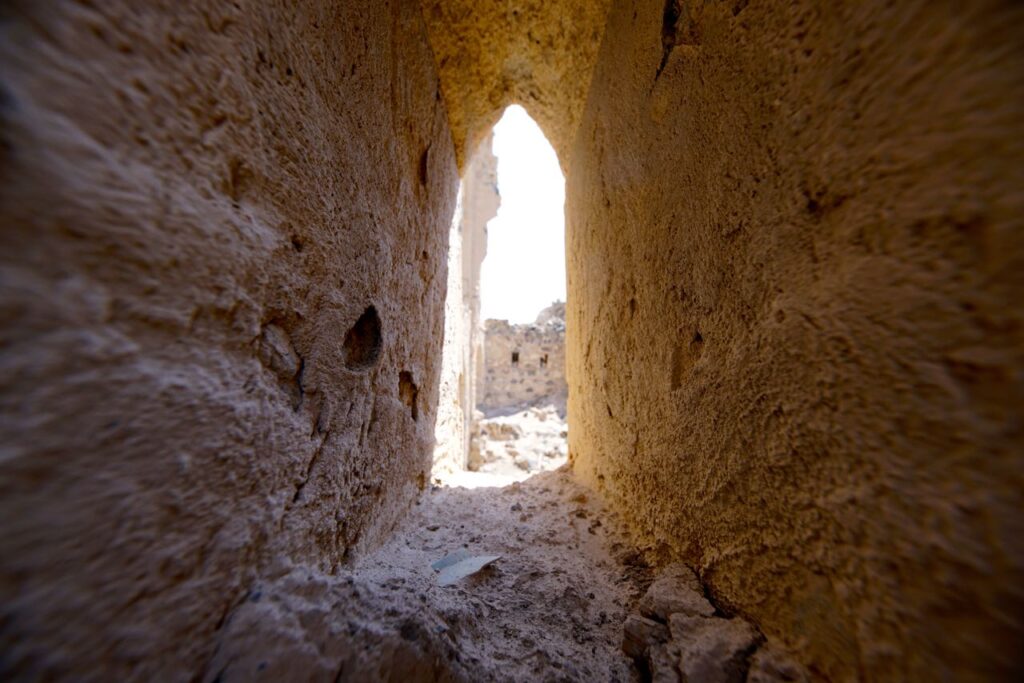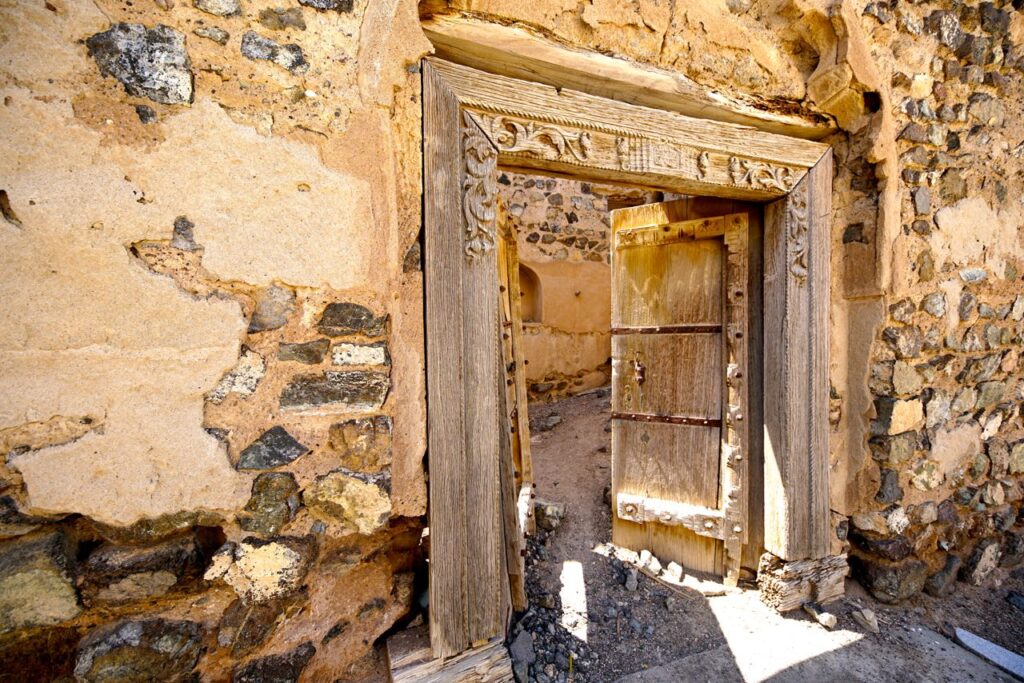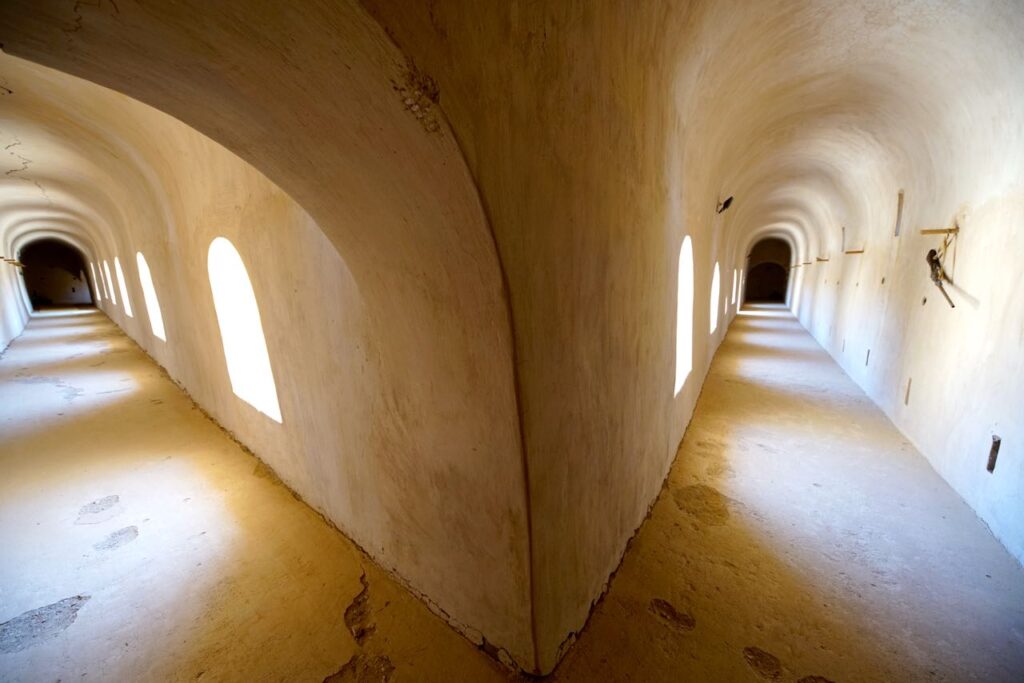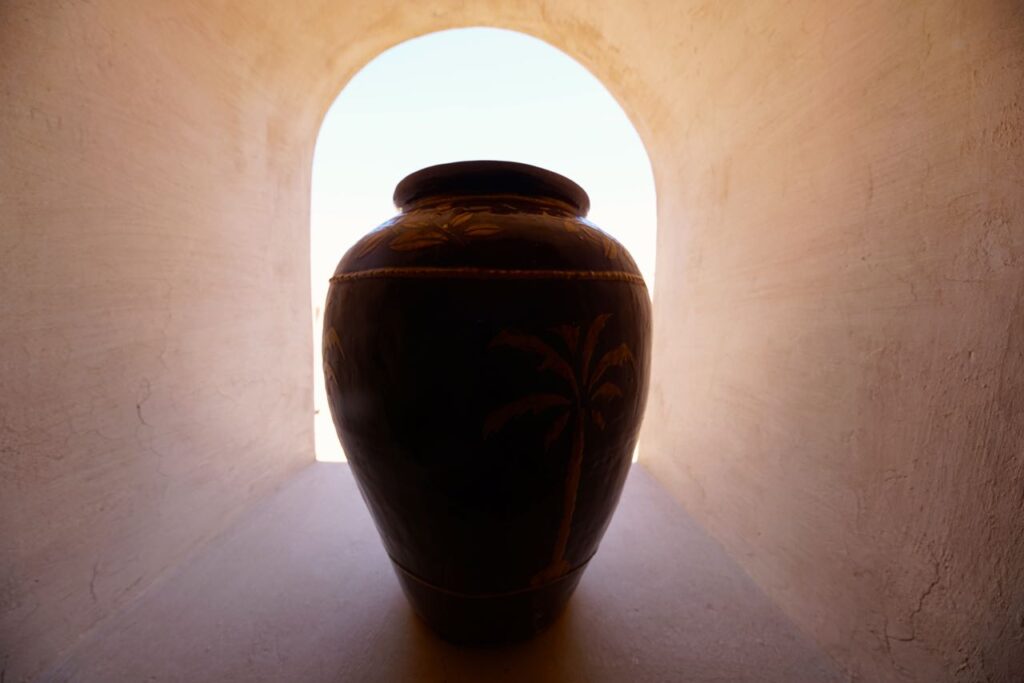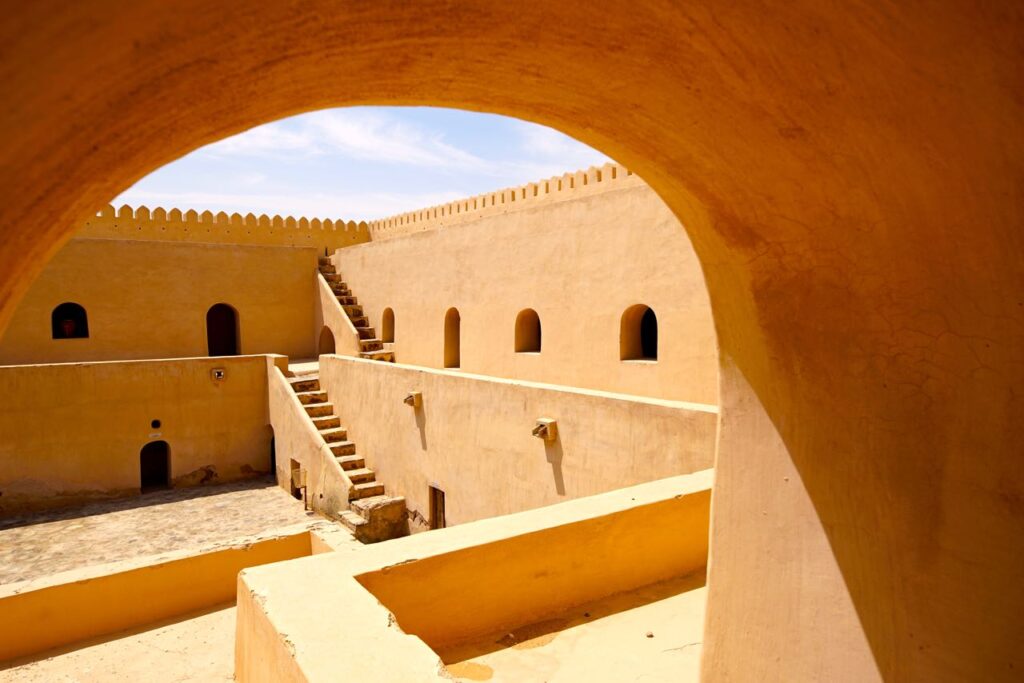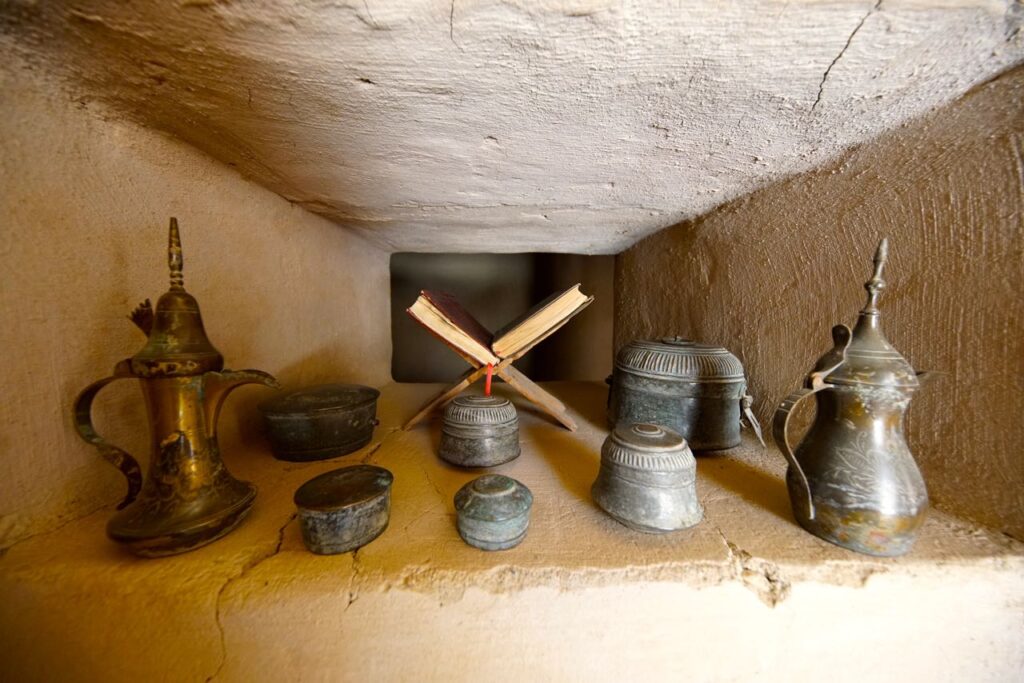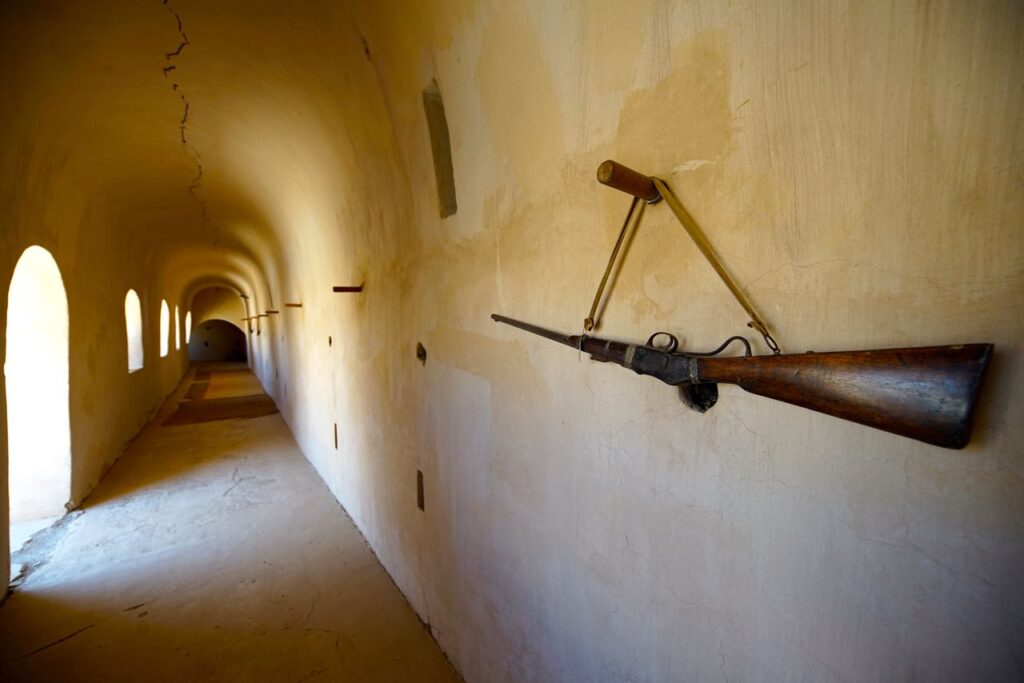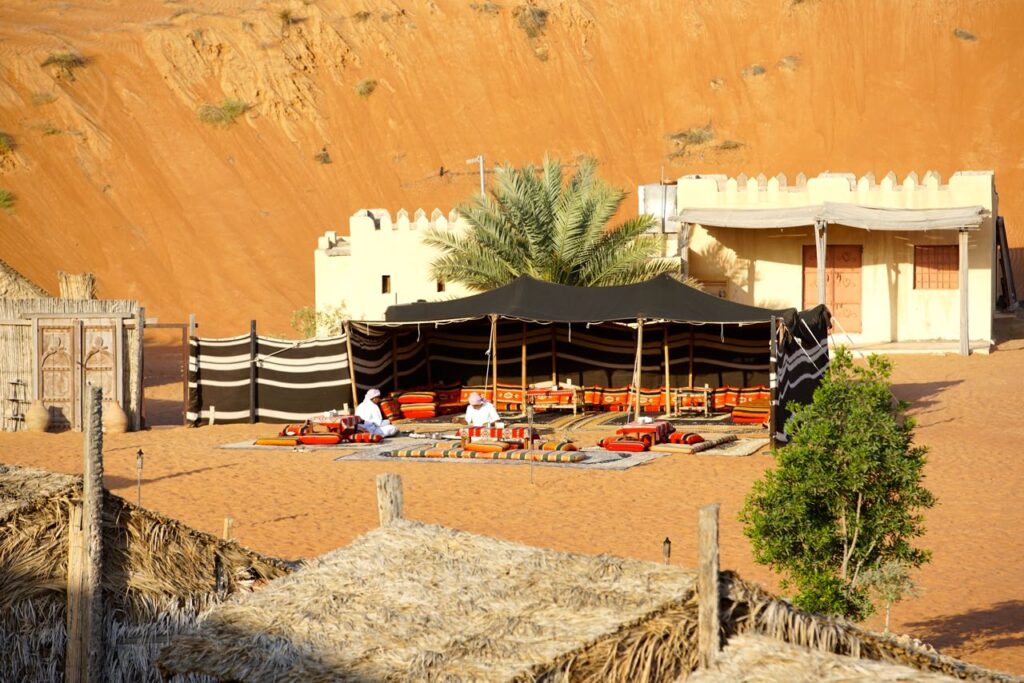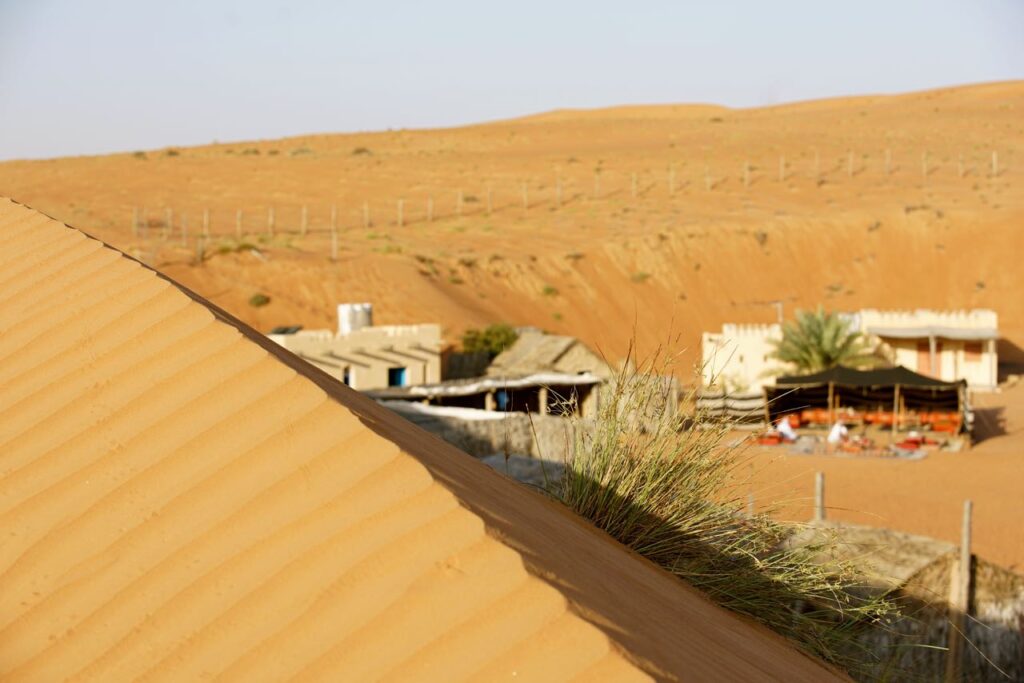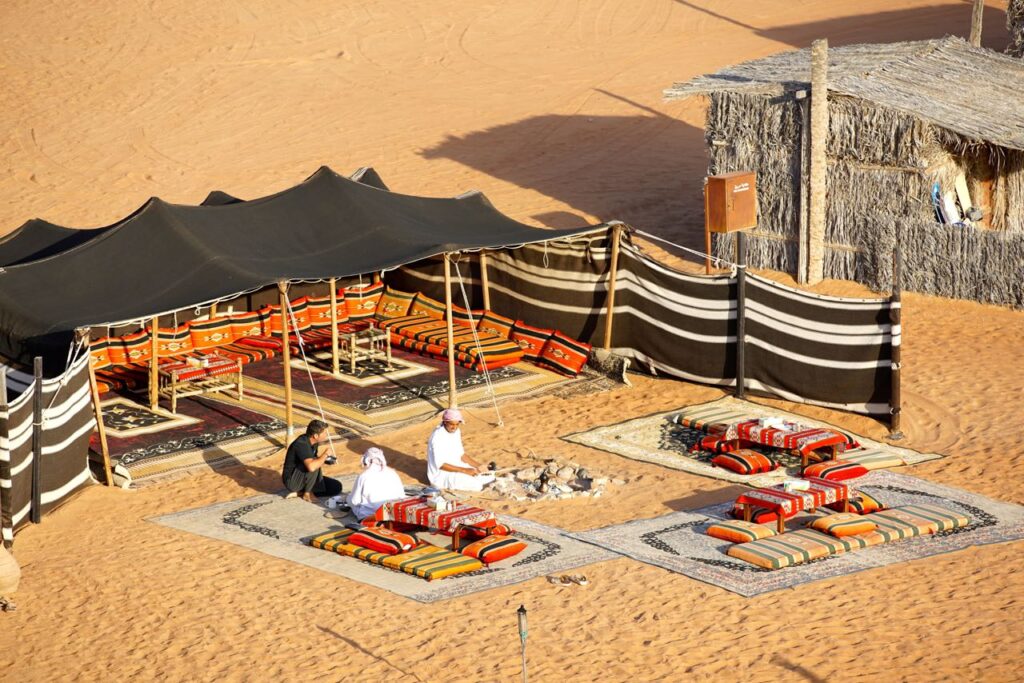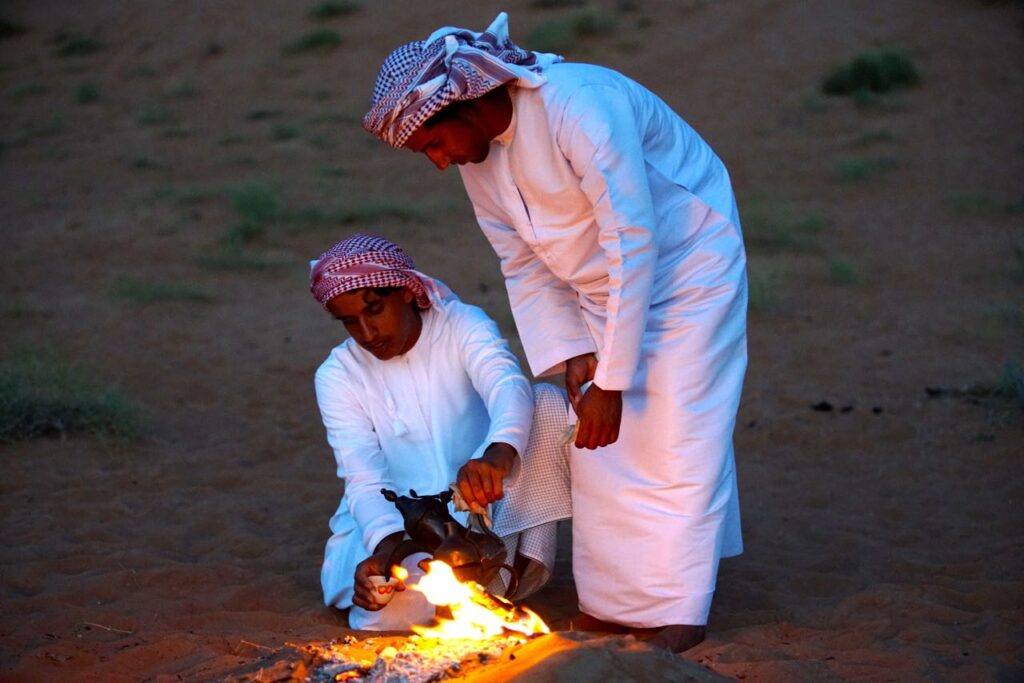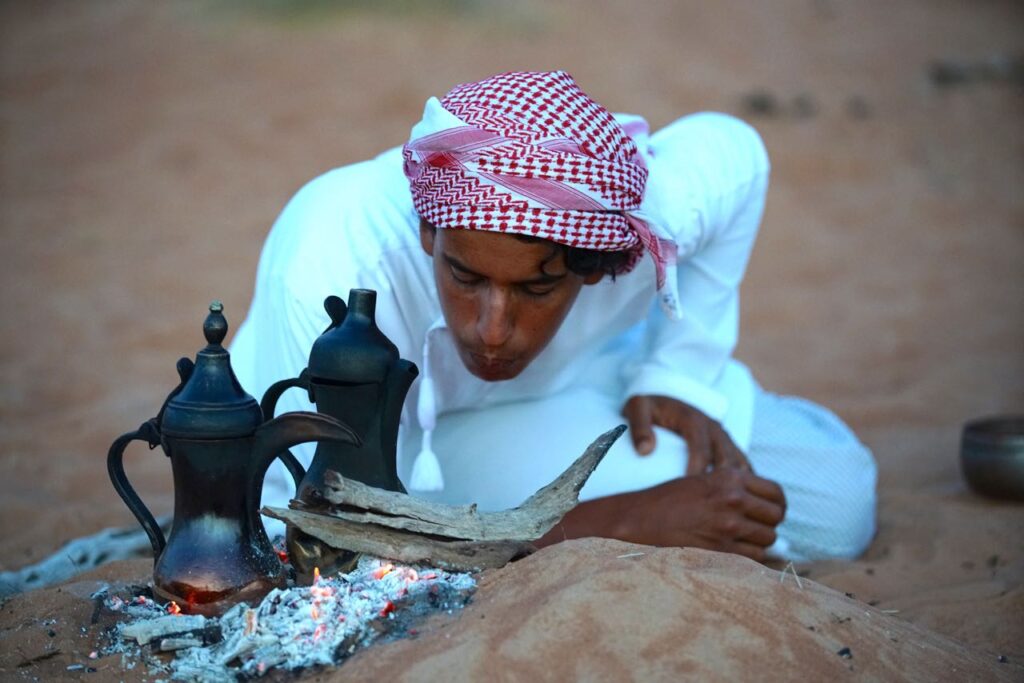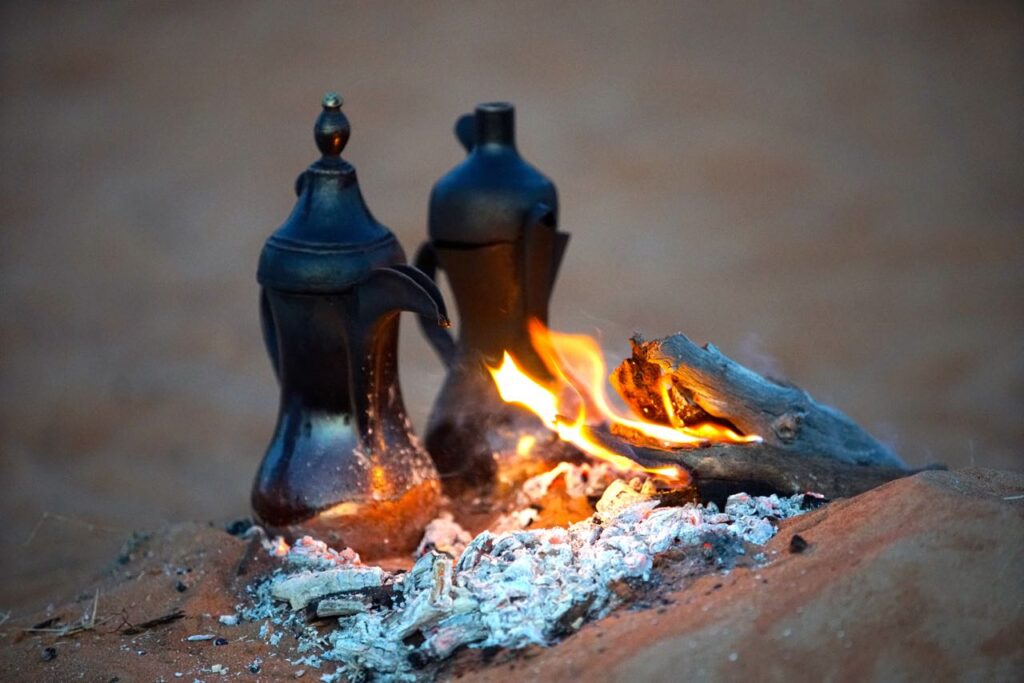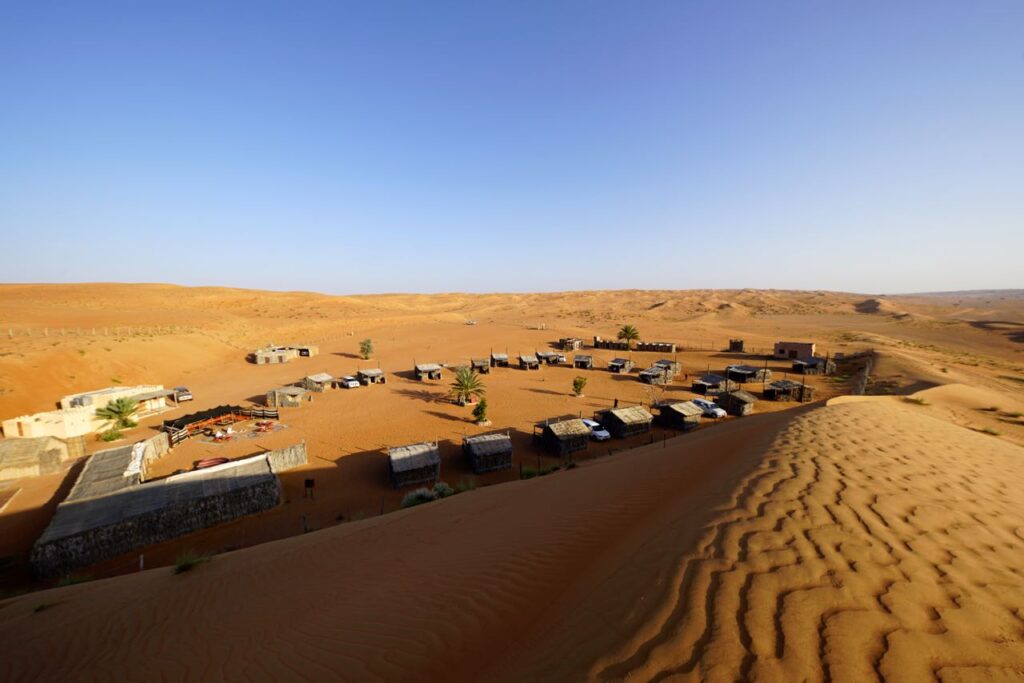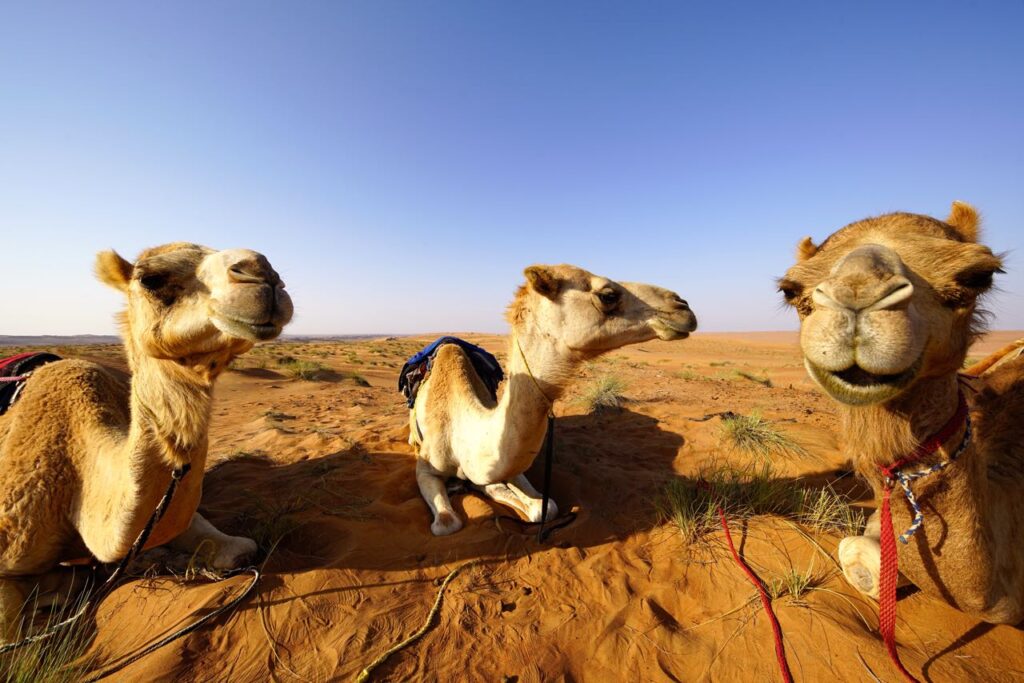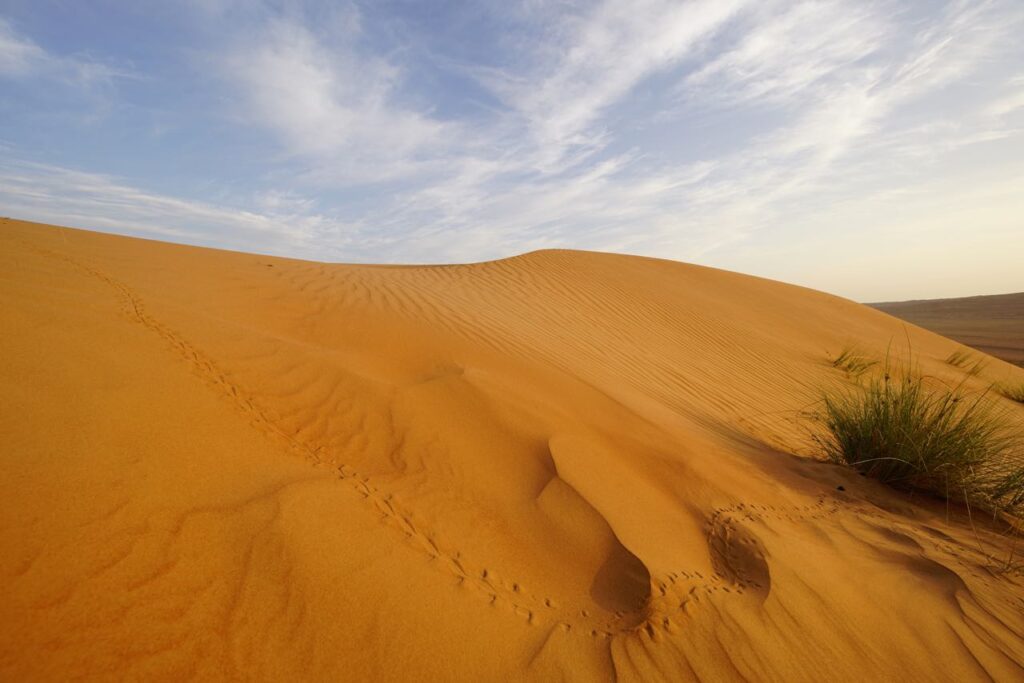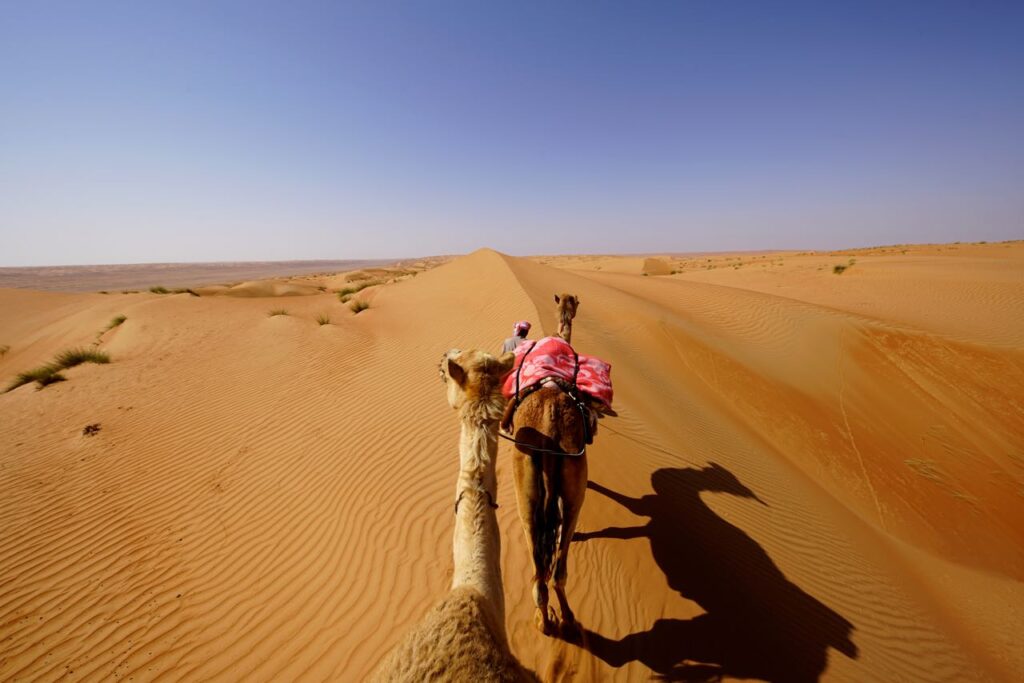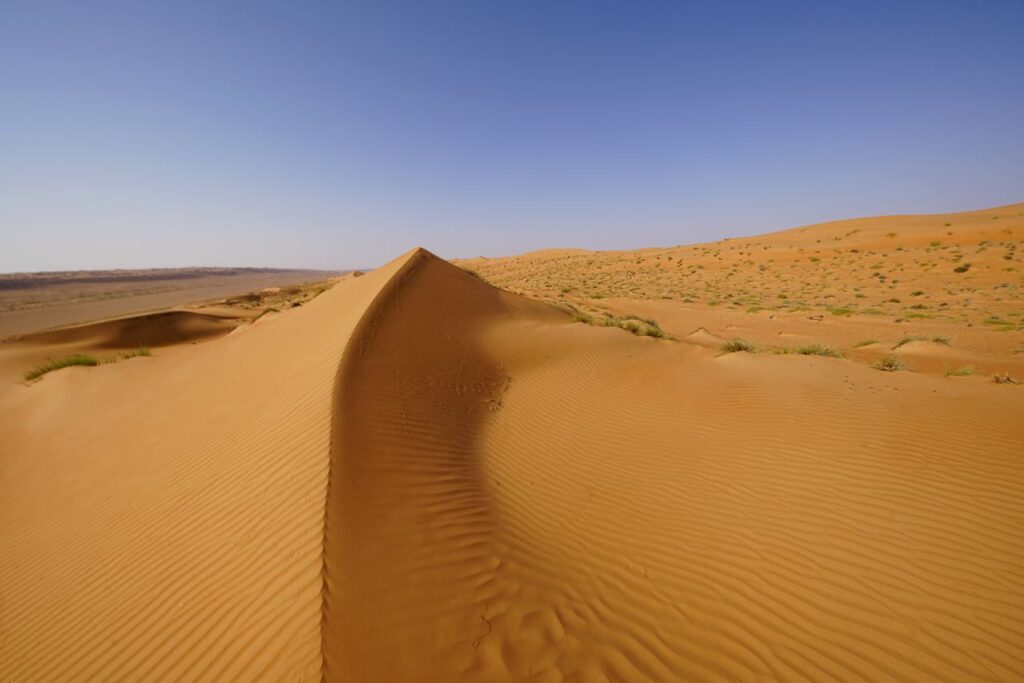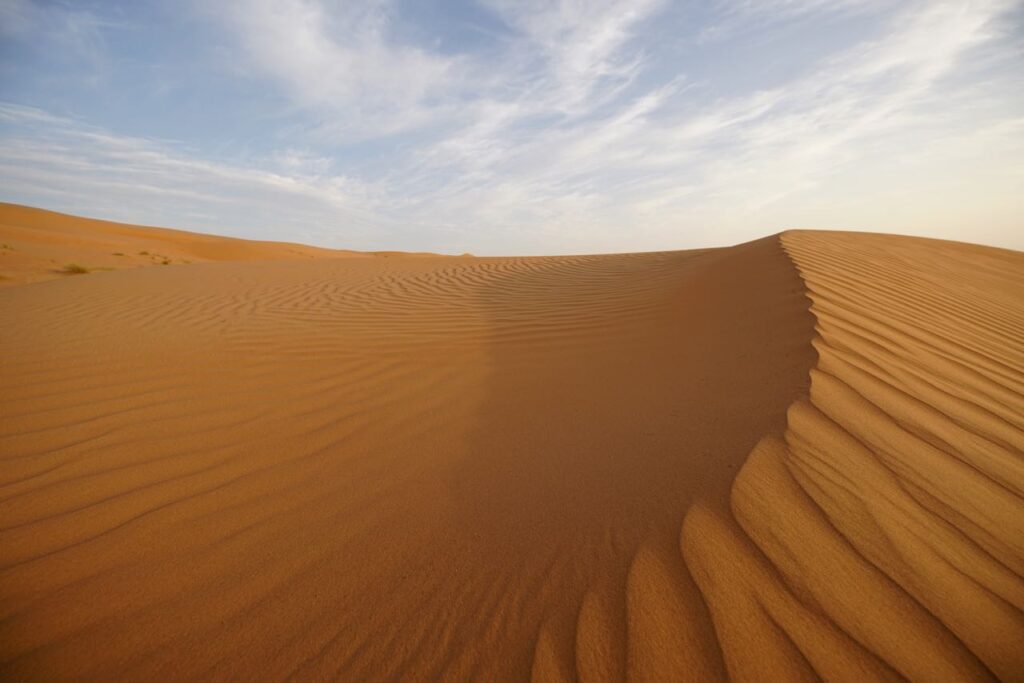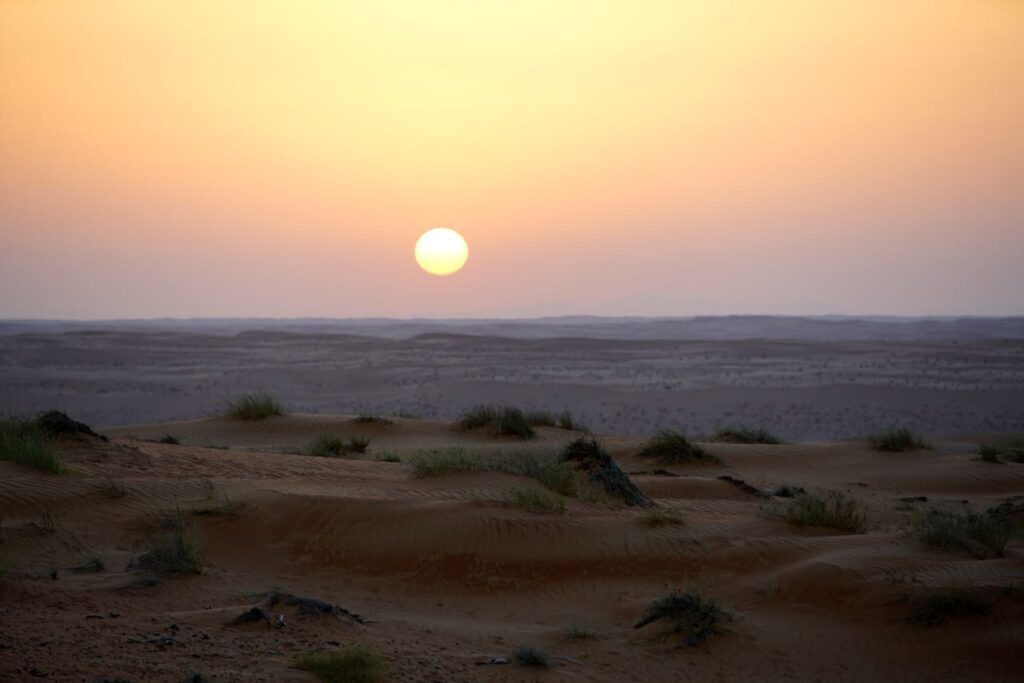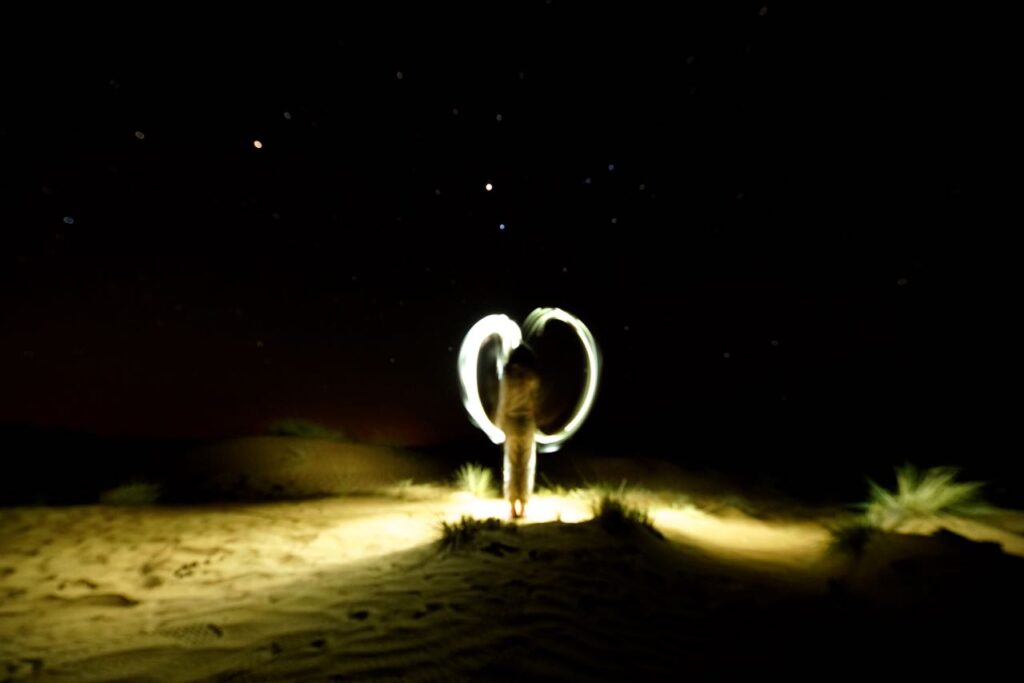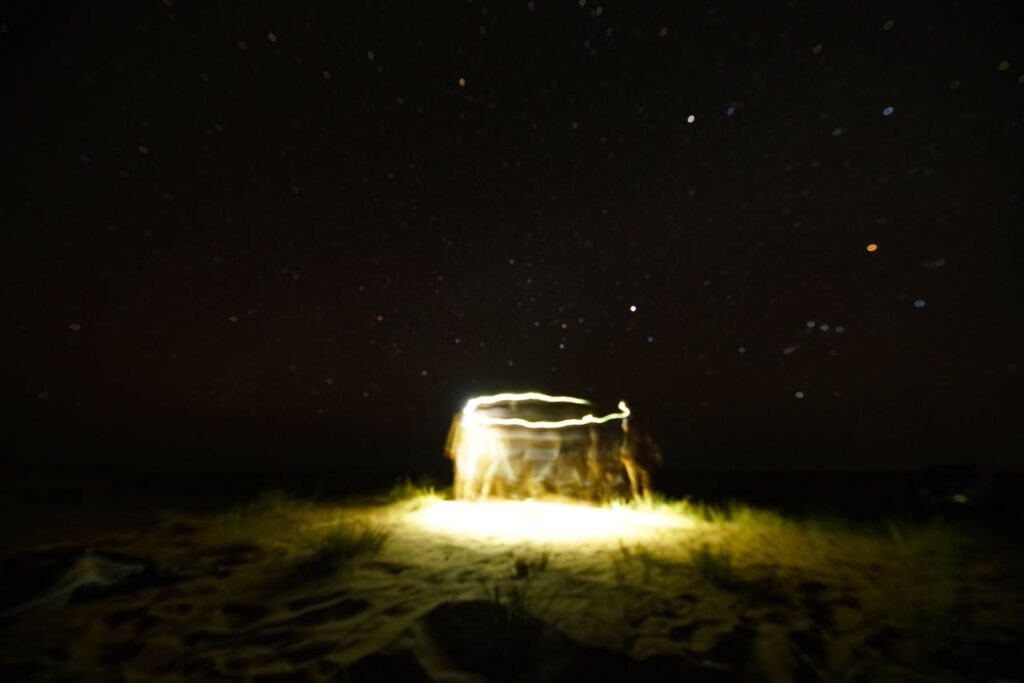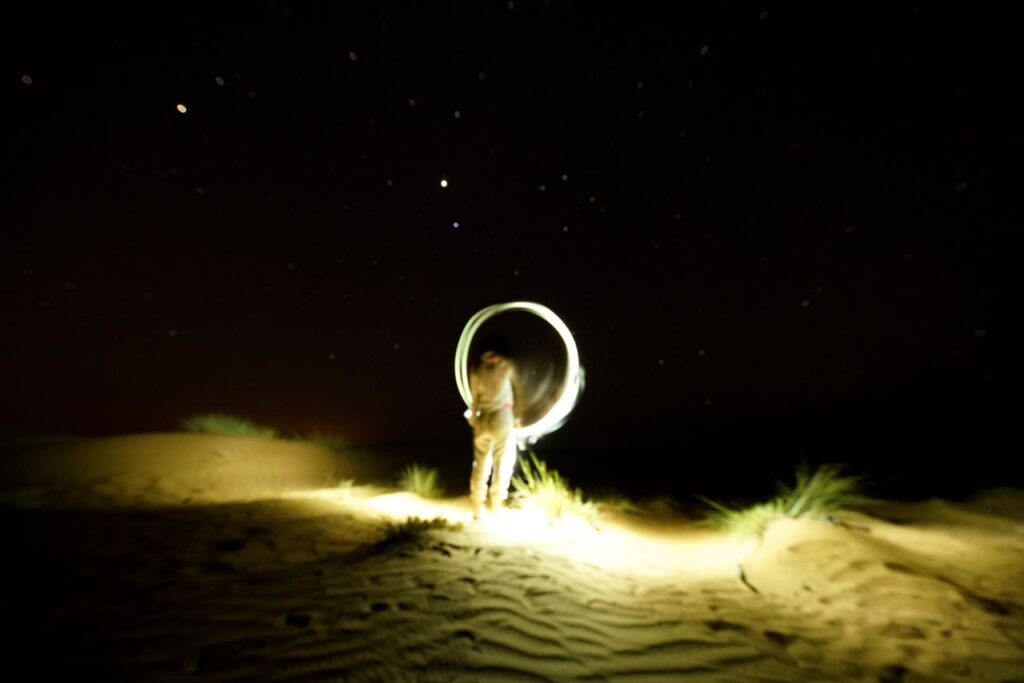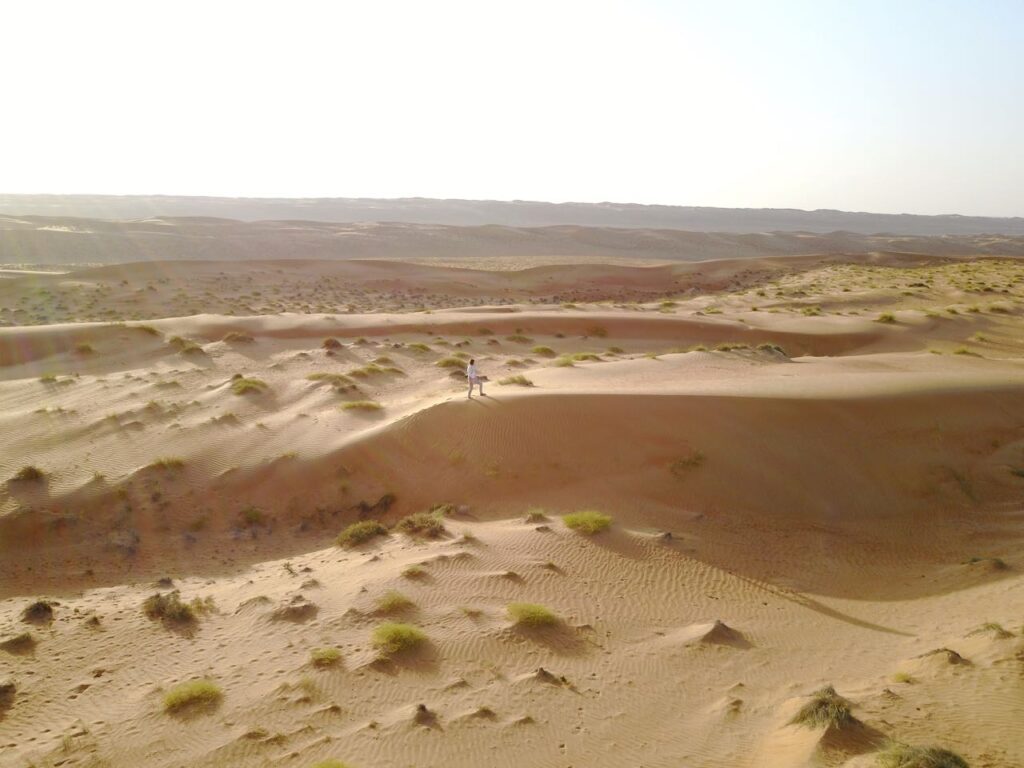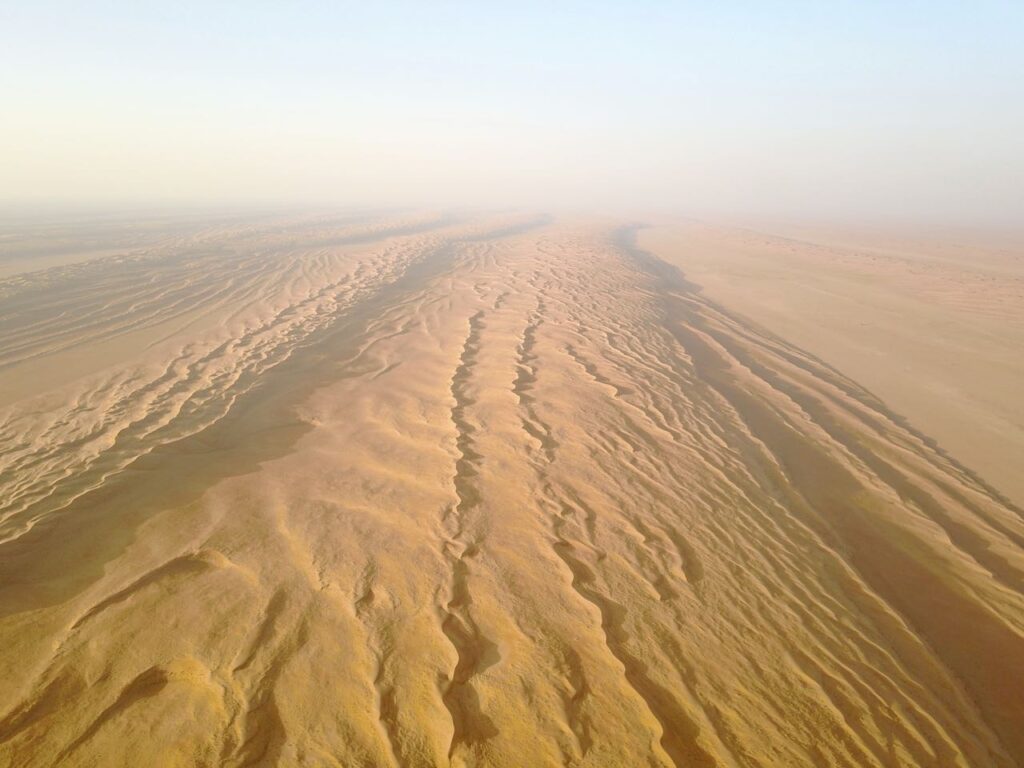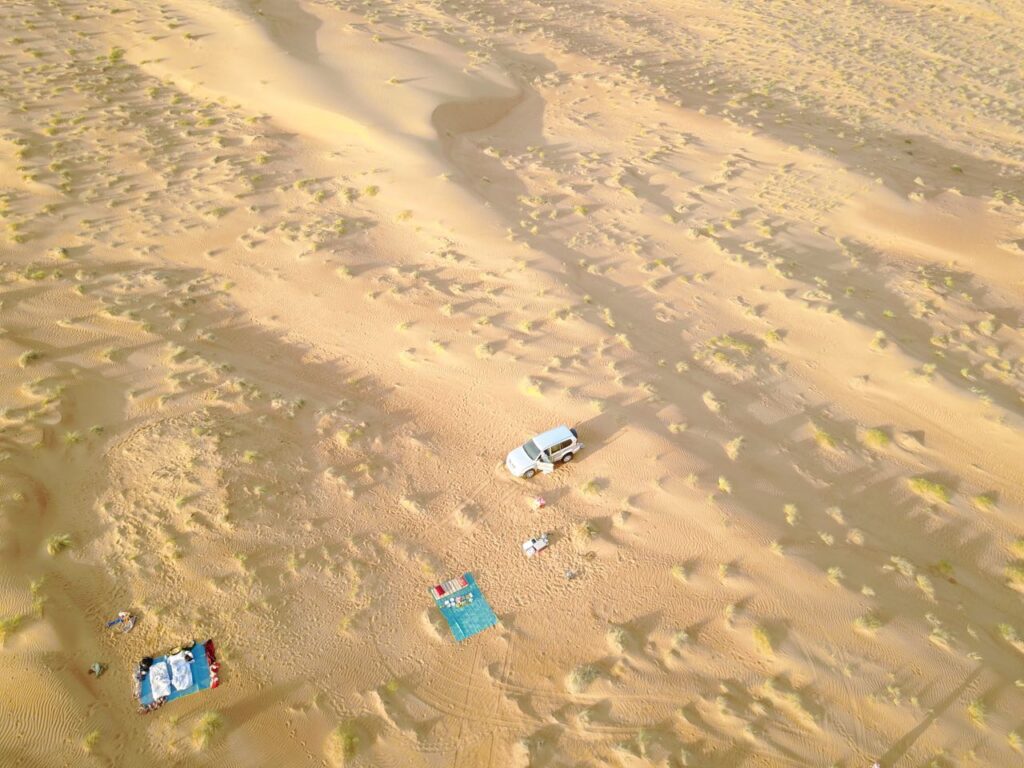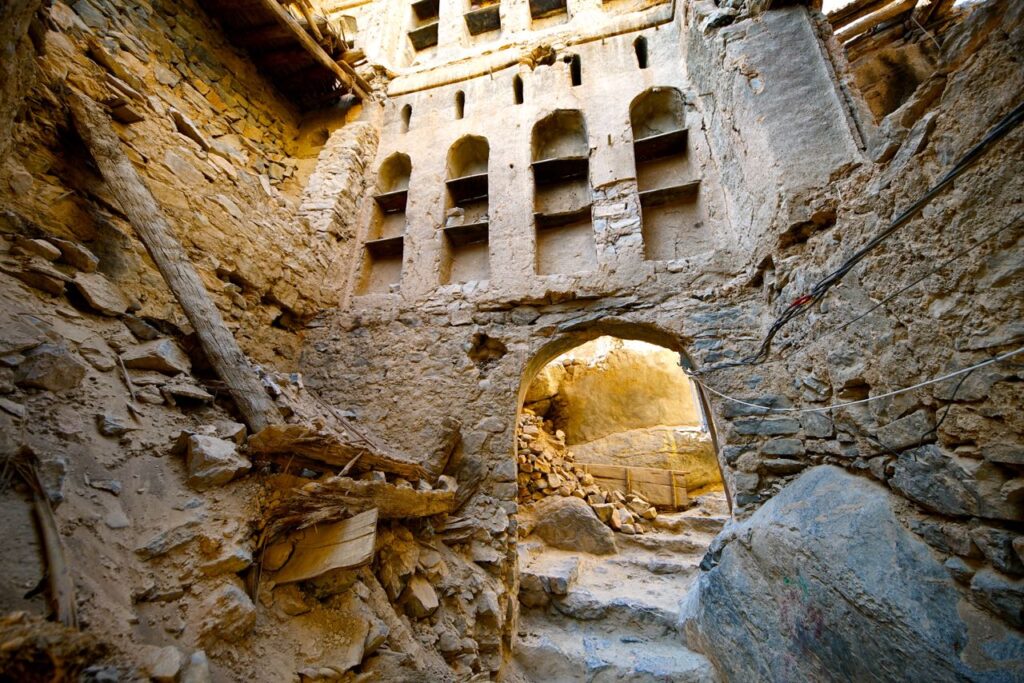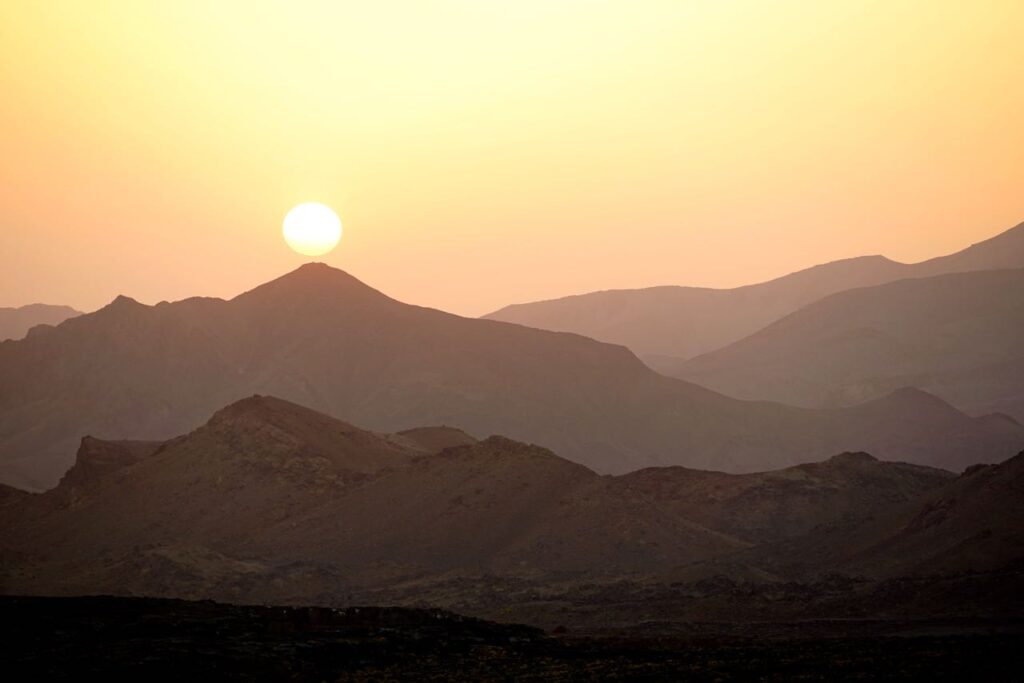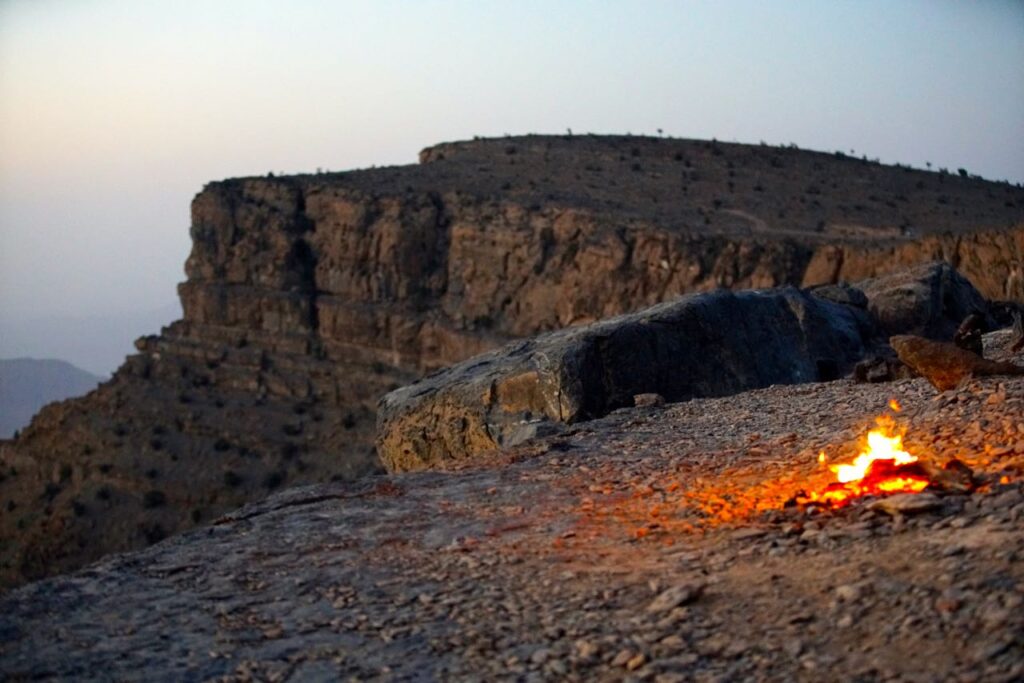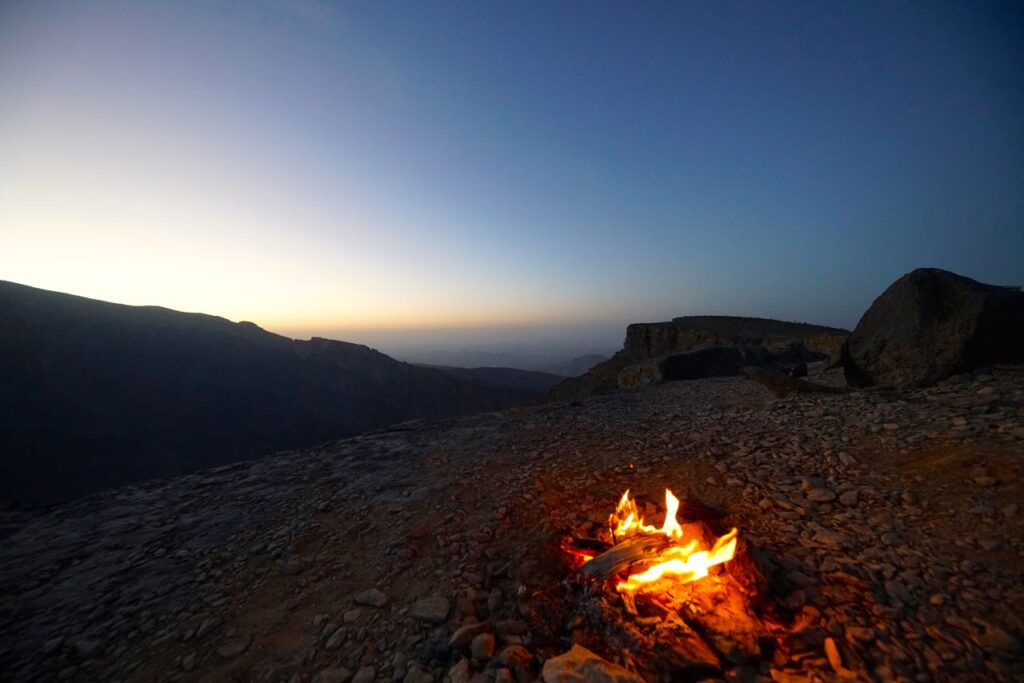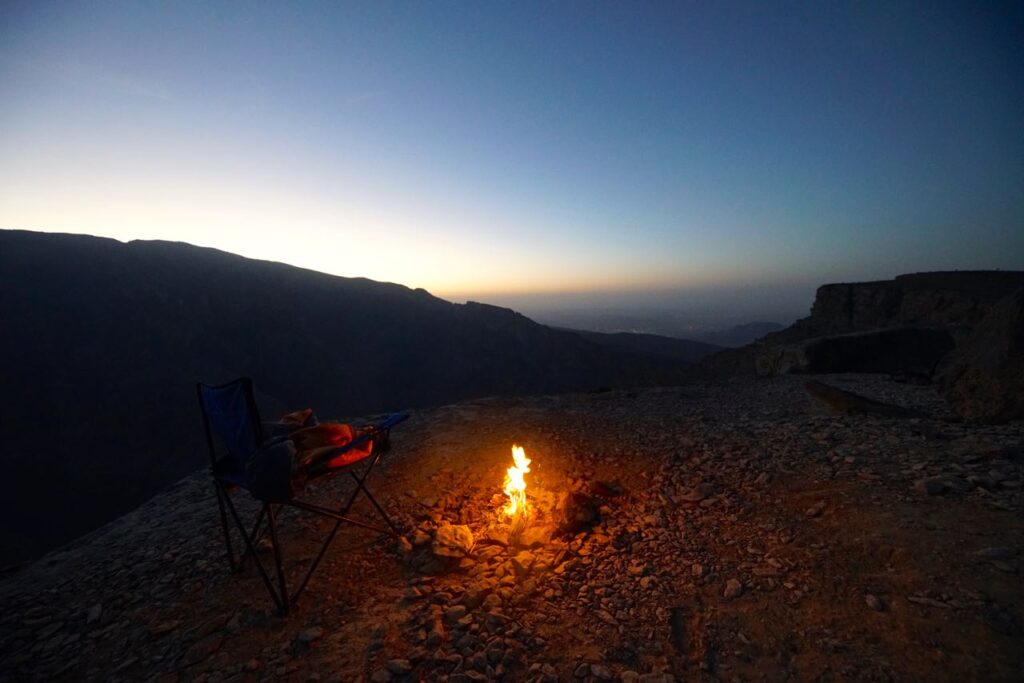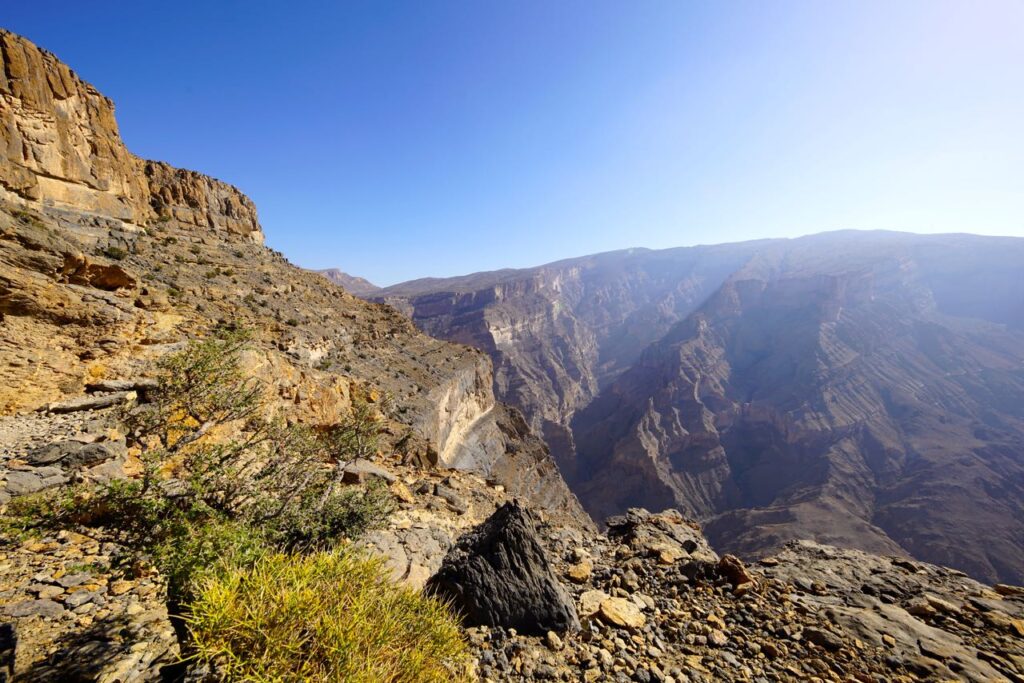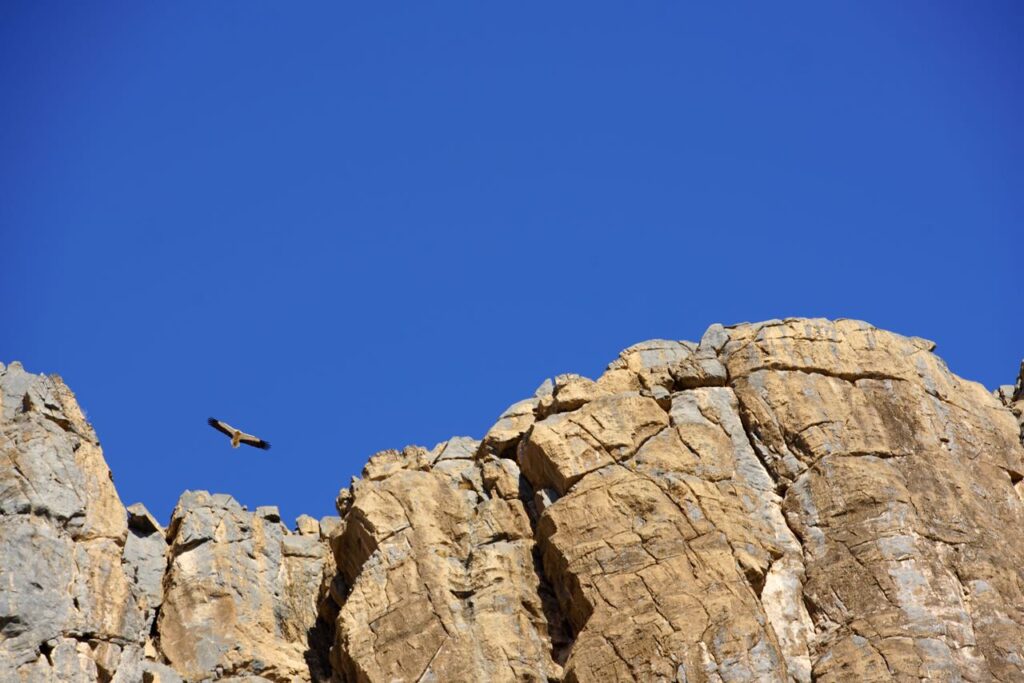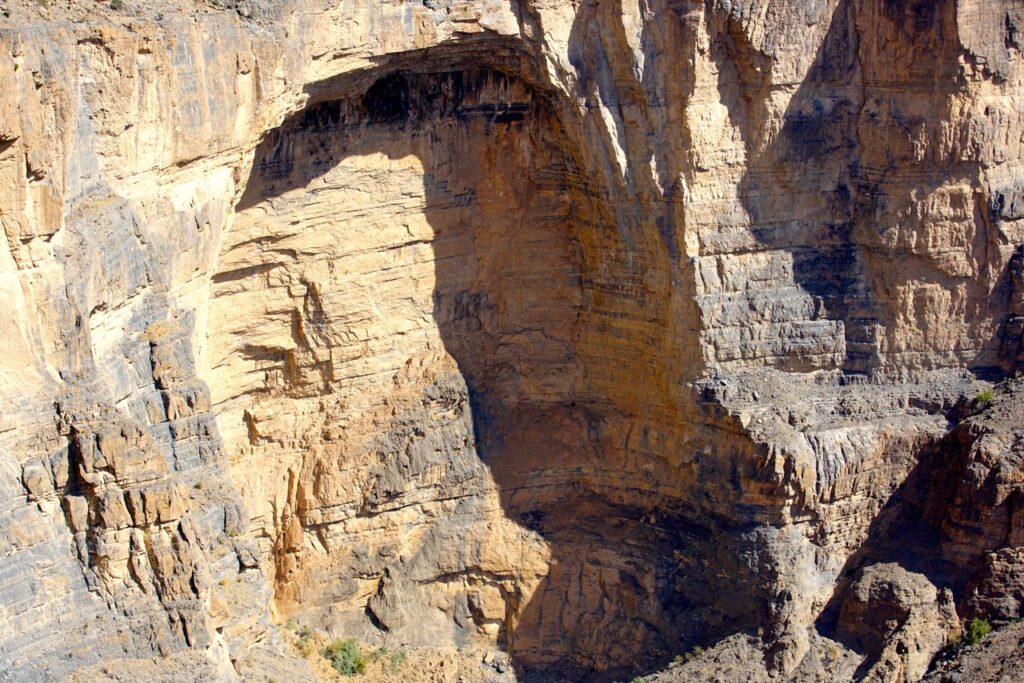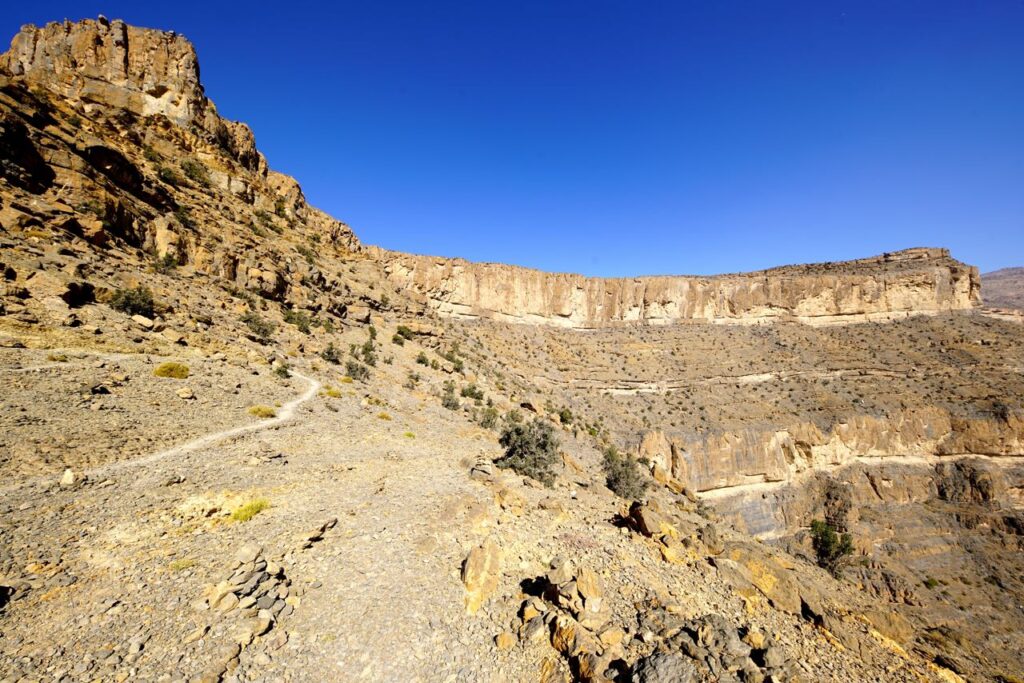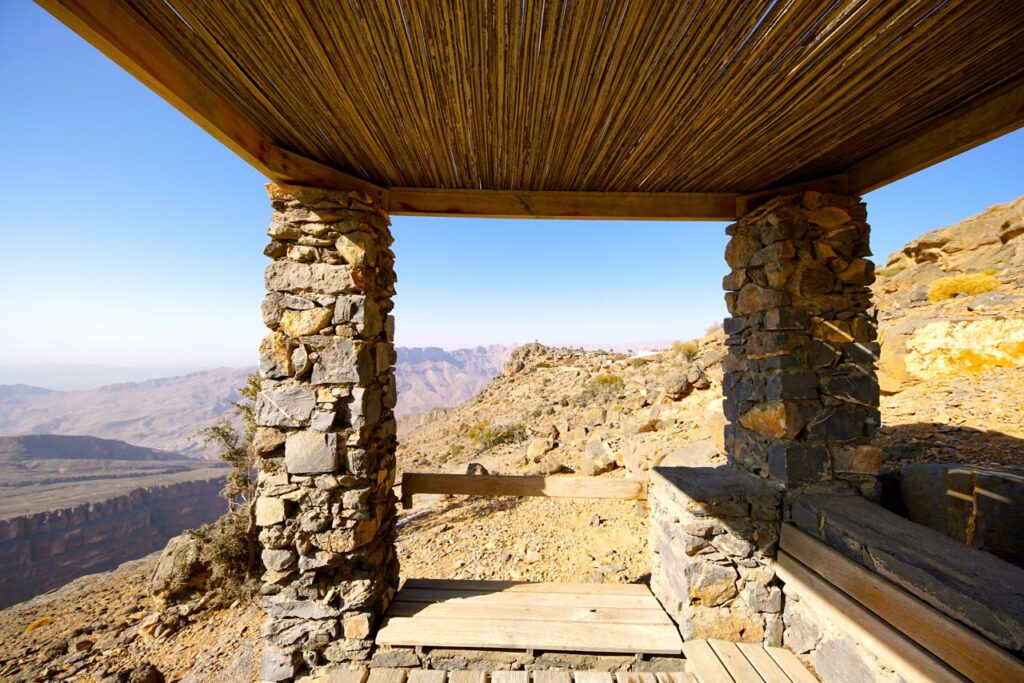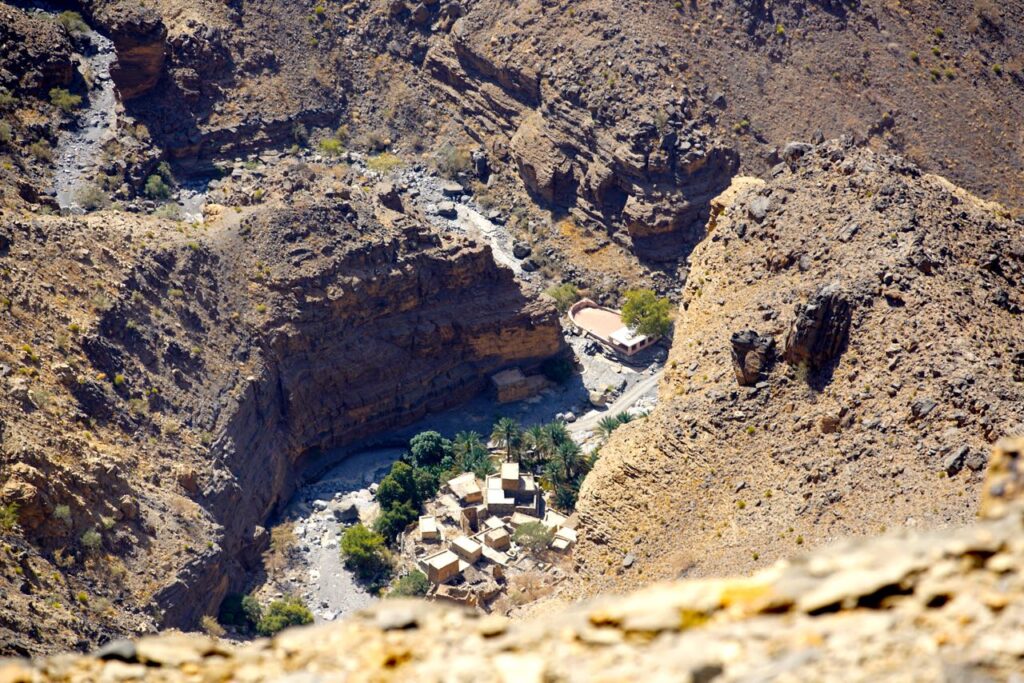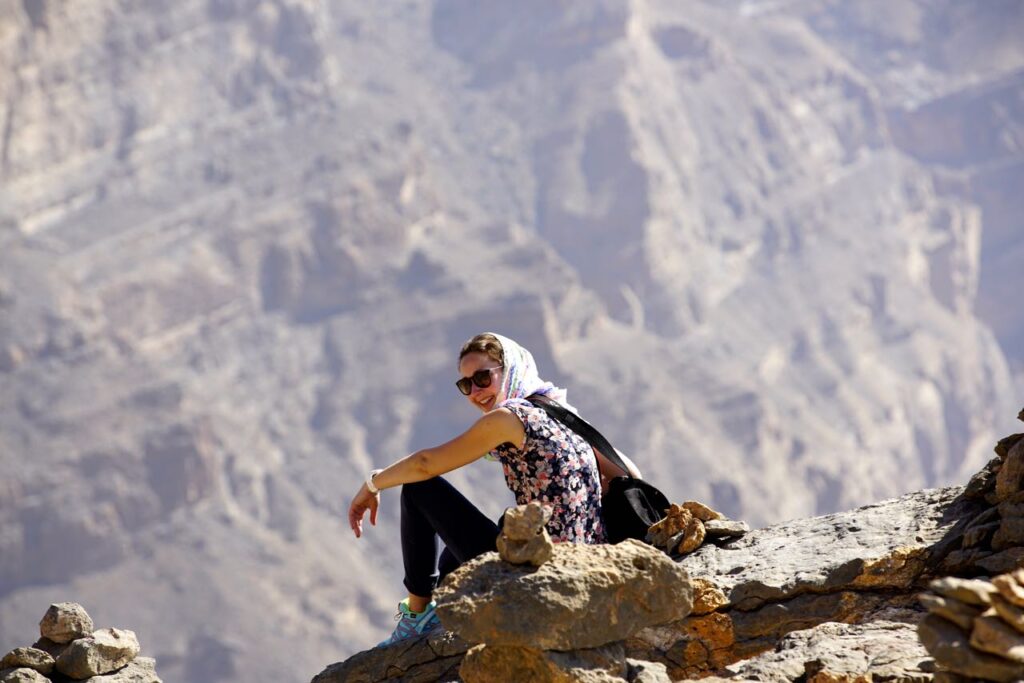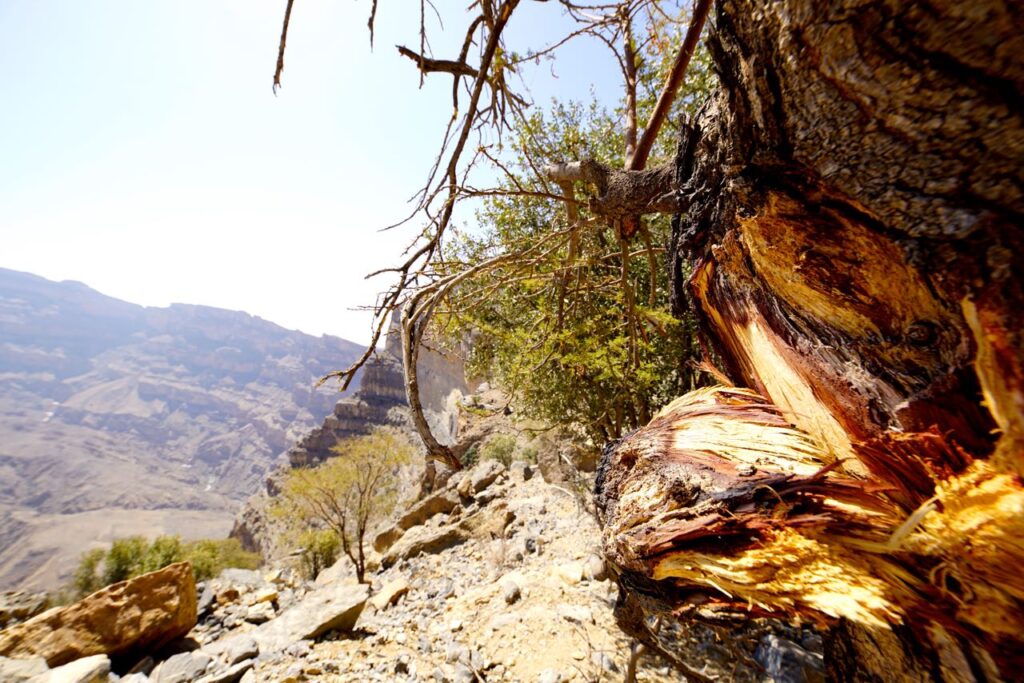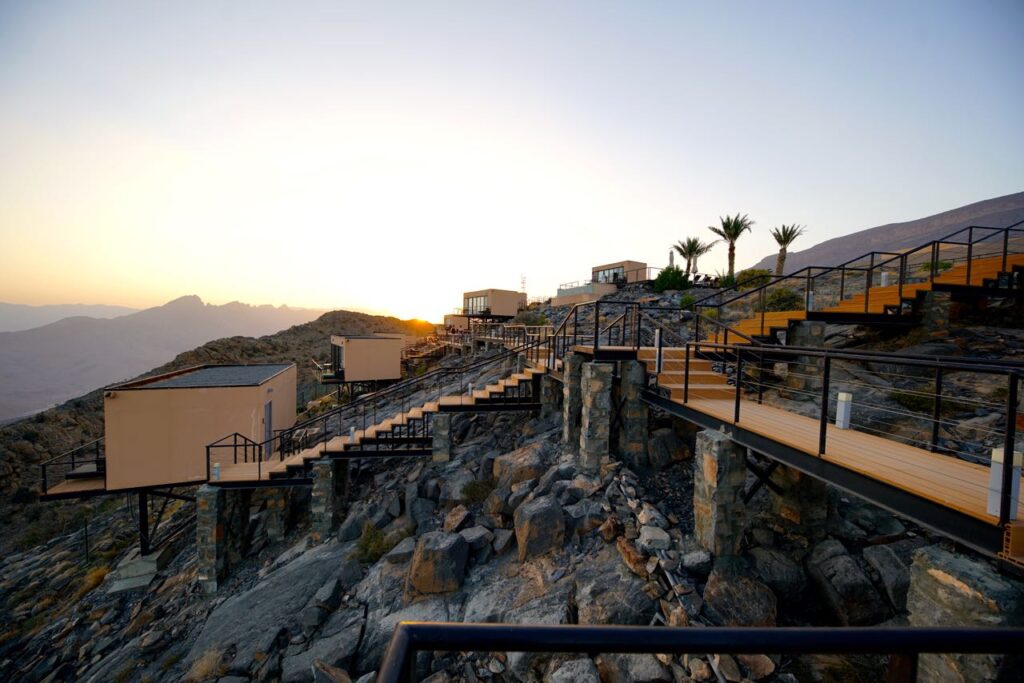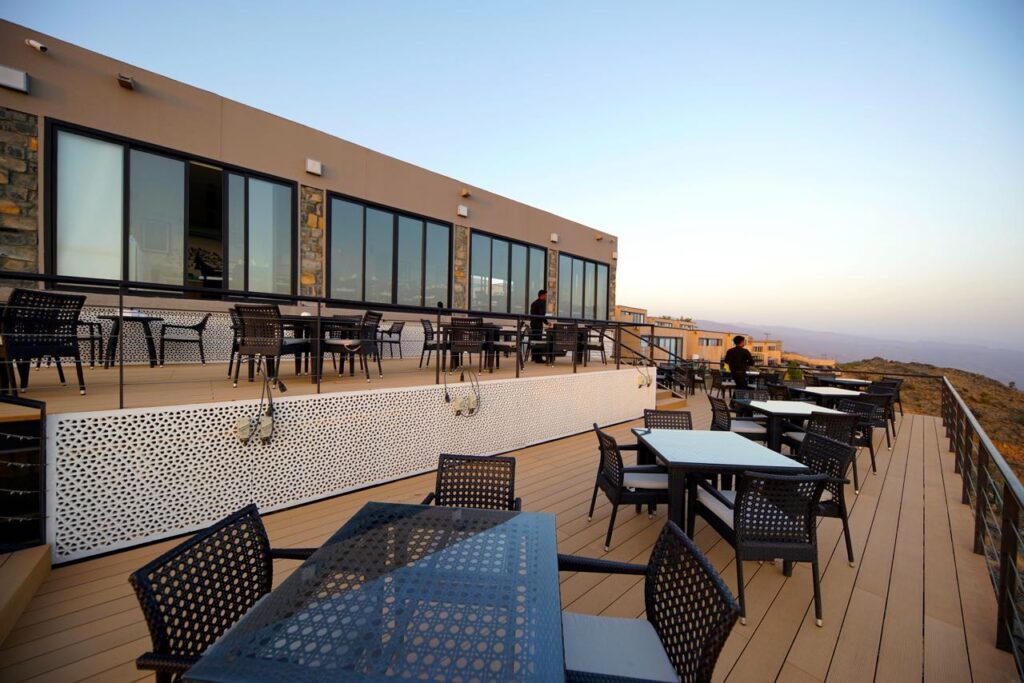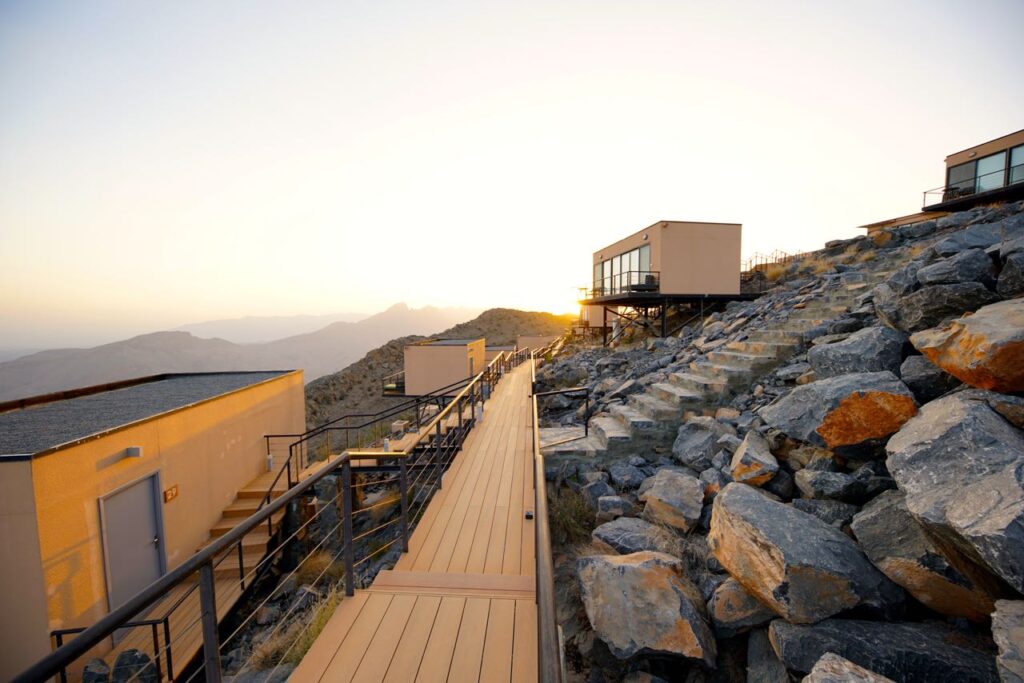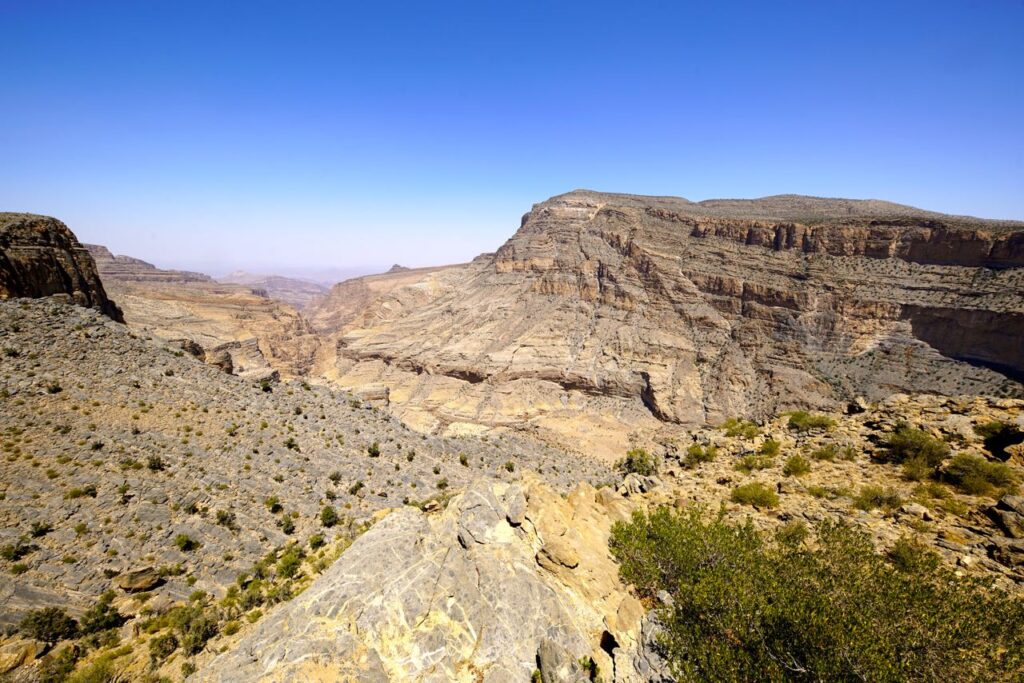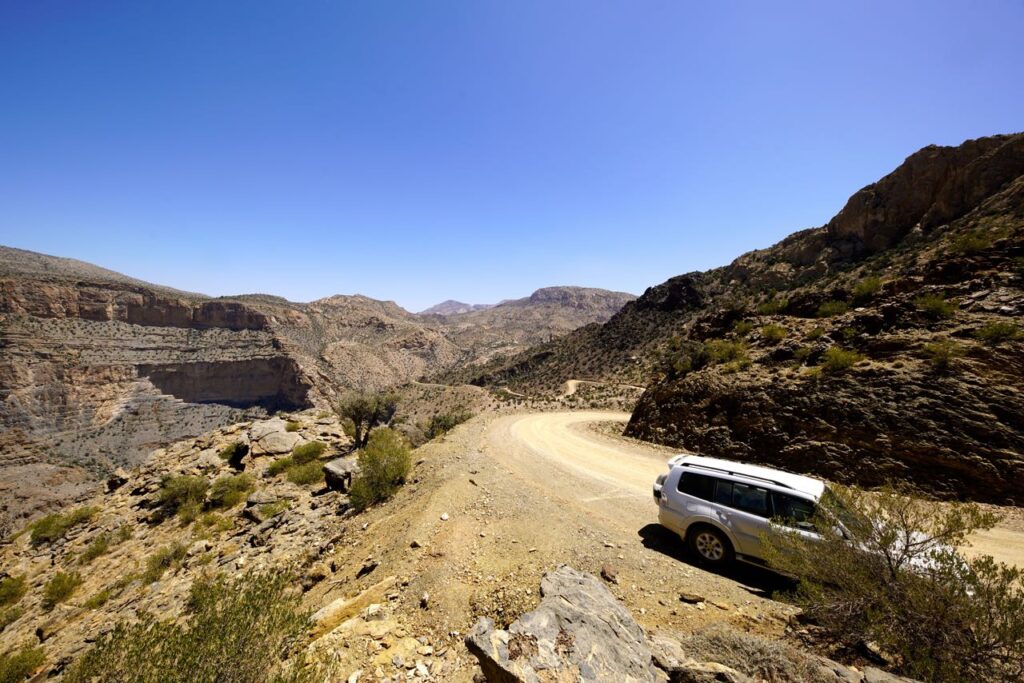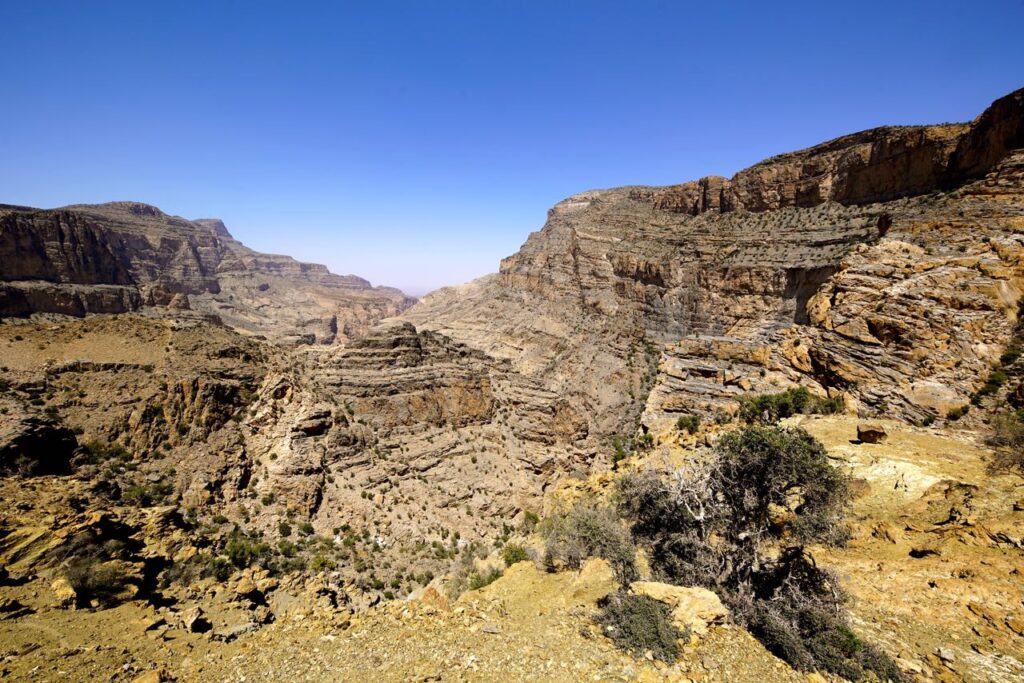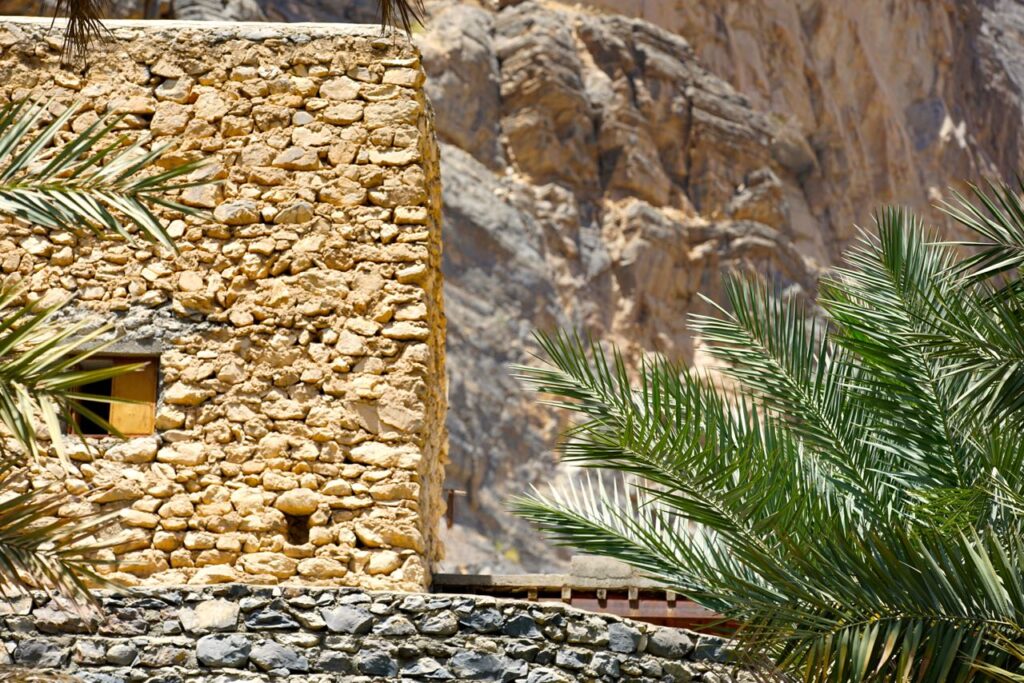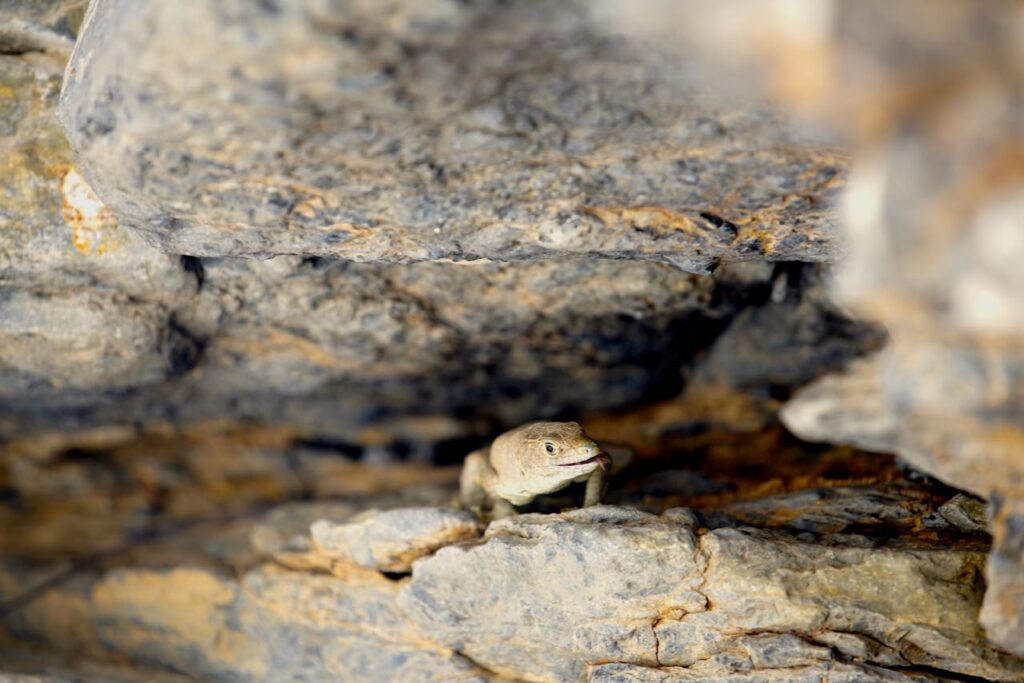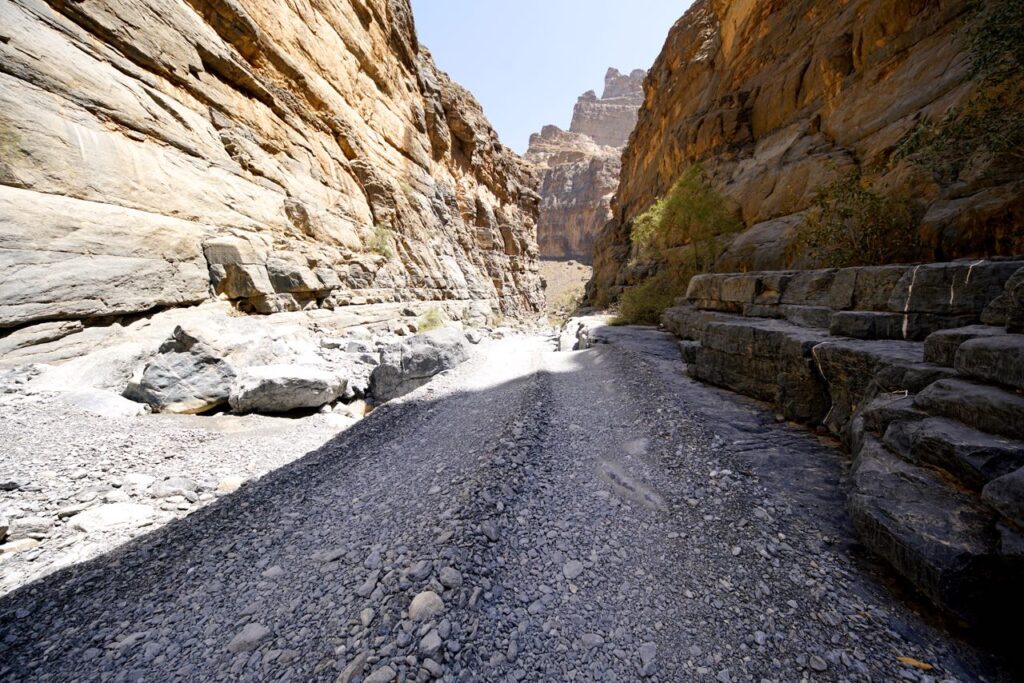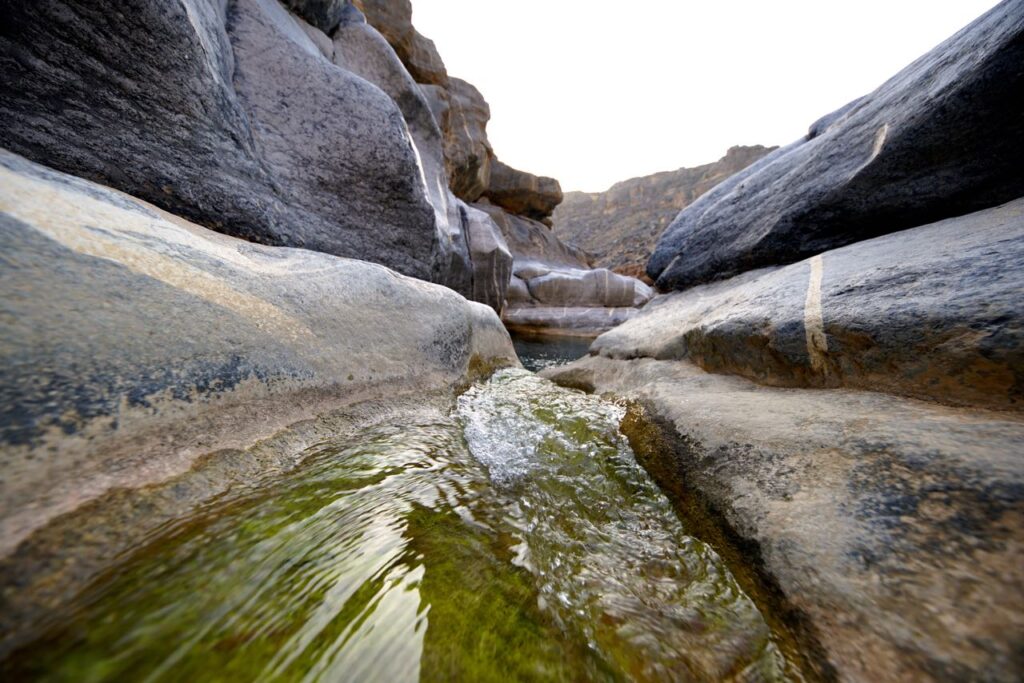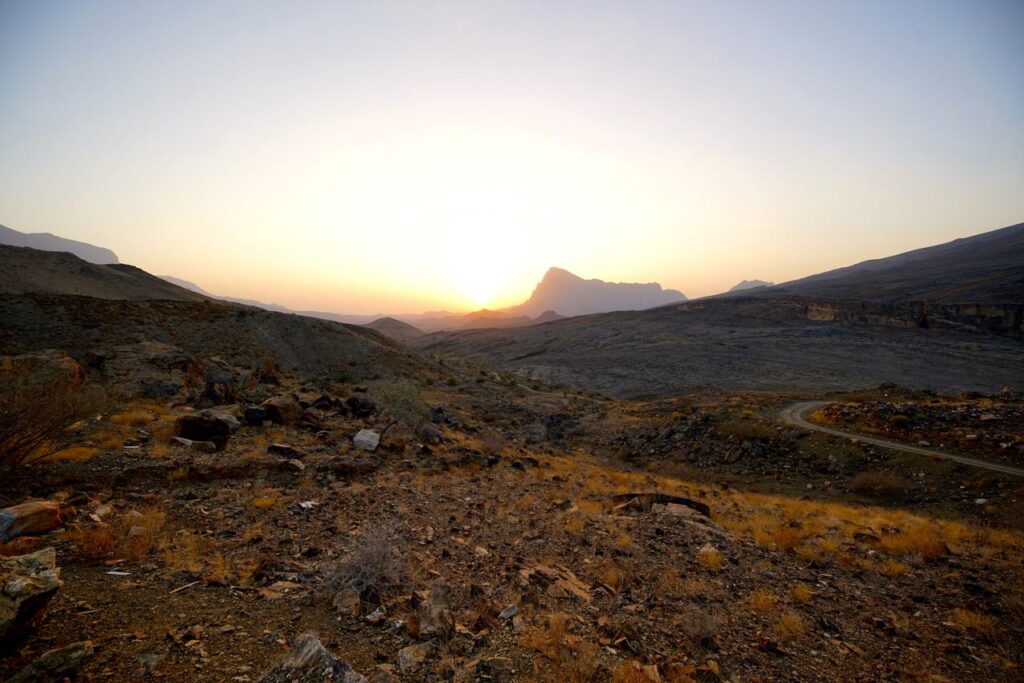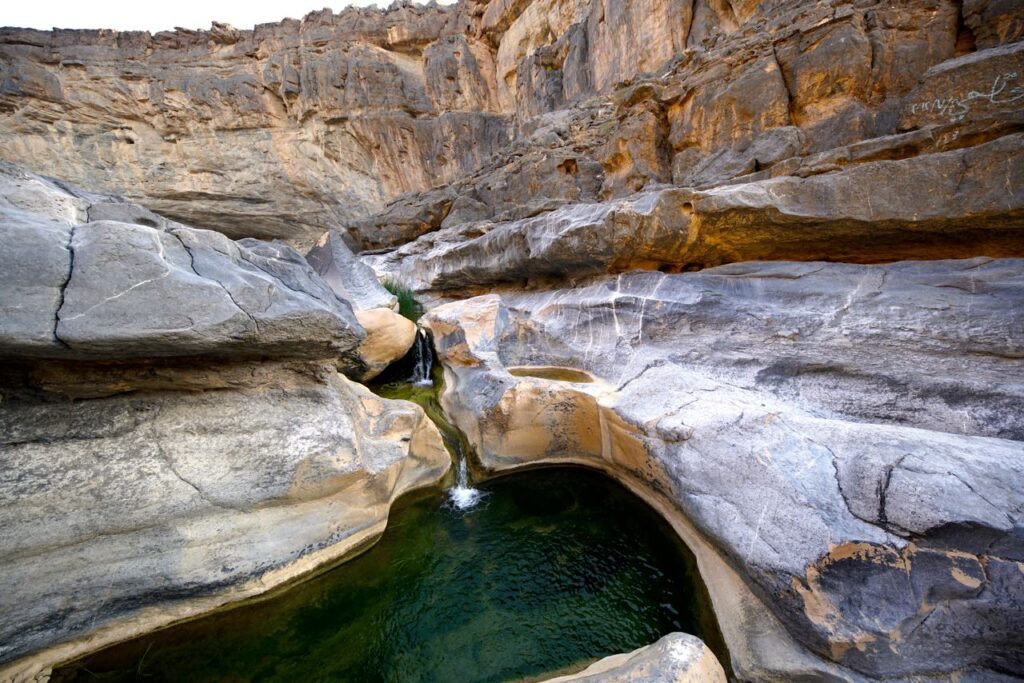Fascinating, moving and an oriental mixture of ‘Thousand and One Nights’ (by Alfred E. Green) with modern times… were our first impressions and experiences in Muscat, the Sultanate of Oman.
As usual and like most of the time by arriving at a country I haven’t been before I got overwhelmed by the wave of new impressions. In situations like this, I often compare the vast change of reality, like it would be a board game where I make huge moves while diving into a new and unknown territory. At the blog post, Oman – Part I, I just described the first six days of our journey (with 2000 words) and I am sure that, based on those facts, your imagination and understanding of the described overwhelming flood of information have grown tremendously, so let’s move on.
I am turning the key while listening carefully to the sound of the engine, everything’s okay and so we move on towards Al Minzafah.
Al Minzafah with the fortress, towers and the abandoned buildings are outstanding traditional milestones which mirrors part of historic Oman. There you find old plastering and inscriptions and even most of the buildings are ruinous by now you still see and feel the glorious past of this region. Time has kept the famous landmarks of Al Minzafah which lies in the district of Wilayt Ibra, the region of Al Sharqiyah.
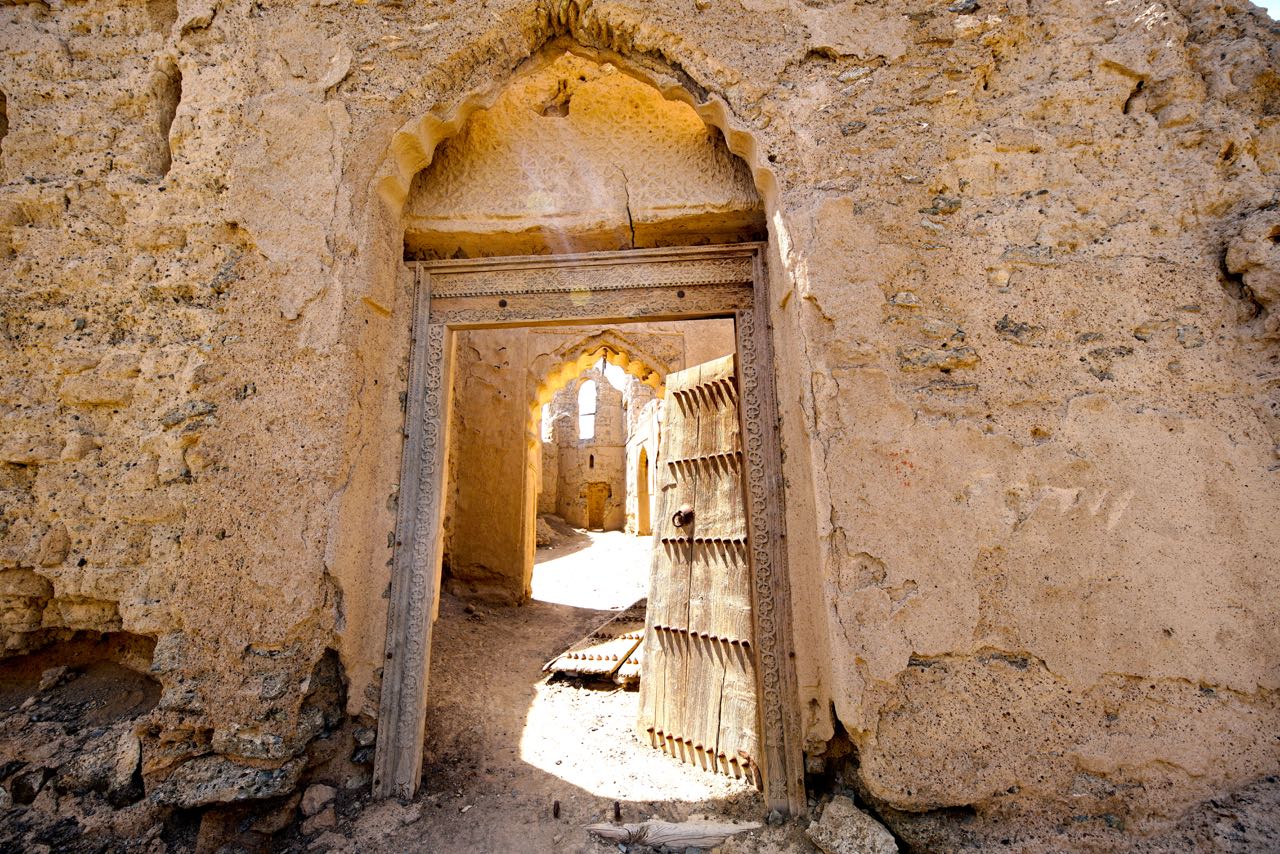
Our last stop before we will drive into the desert of Wahiba Sands is the fortress Al Mintirib, which was built in the 13th century in the middle of the town Al Mintirib, (Wilayt) Badiya region of Al Sharqiyah. It served the whole population as a protecting shelter against enemy assaults. During the leadership of Imam Azzan bin Qais Al Busaid the fortress was rebuilt and used as a seat of power where governing authority ruled over the whole region. The square-shaped fortress (900 square meters) is an interesting cultural sight with lots of different rooms (drifting through those rooms felt a bit like time travel).
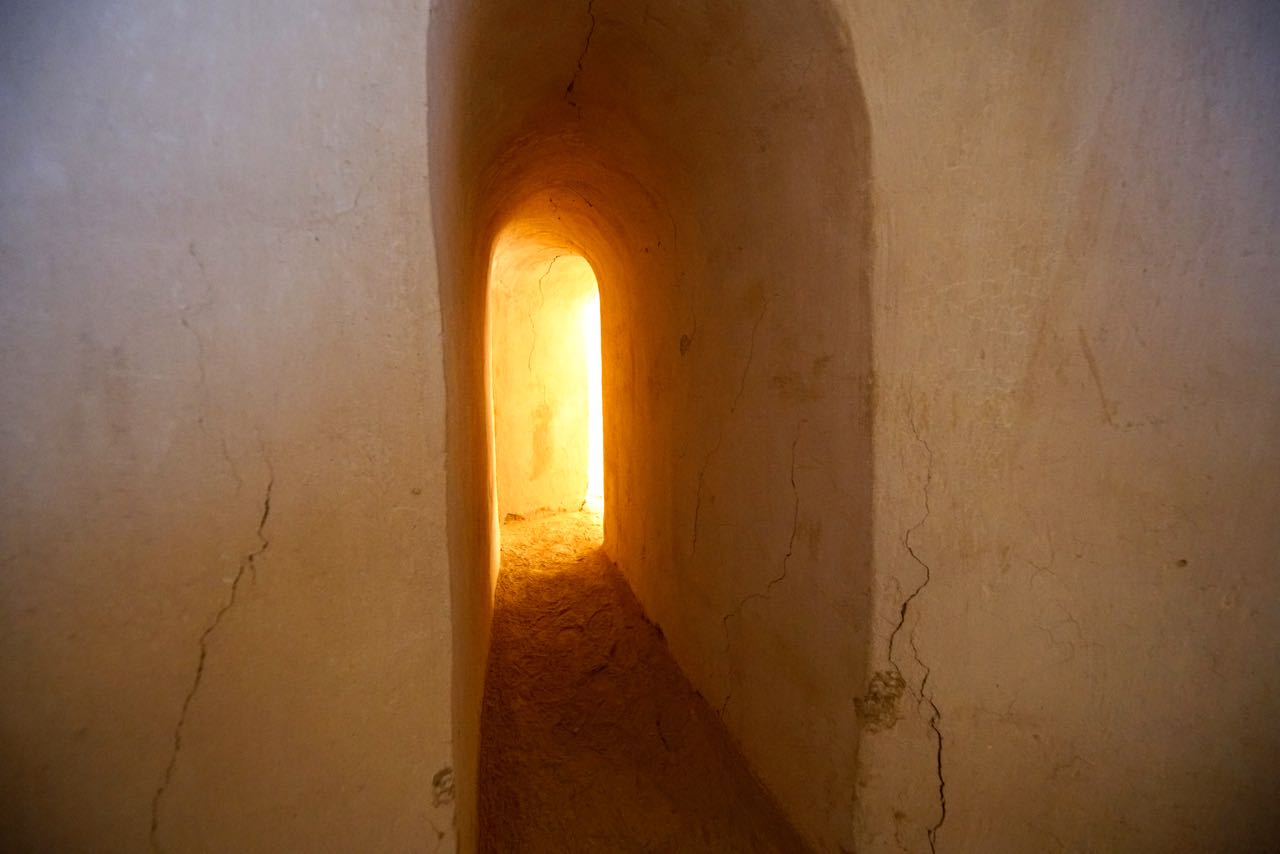
After finishing the tour in the fortress we finally moved on to a close by a garage, the meeting point with our guides from the Nomadic Desert Camp. The garage itself was in the same color like its surrounding, a perfect camouflage of dust! We could not see anybody but we heard somebody snoring on an old shredded bench seat. We gave the bench a smooth shake up and the person jumped up immediately and acted like he was never sleeping. Without asking, obviously knowing what we need, he went straight to our Toyota and reduced the air pressure on each tire down to 1.3 millibars. Wahiba Sands we are coming… and with that amount of pressure in the tires we were drifting, actually floating over the hot desert sand. We reached the Nomadic Desert Camp by late afternoon where we got treated with fresh dates and Omani Coffee. The red color line in the following picture shows you the off-road drive into Wahiba Sands Desert (which took us about 30 minutes) and the green color line symbolizes our tour on the dromedary (also called: Arabian Camel or one-humped-camel). This part of our Oman tour we booked in advance, including the dromedary adventure ride where we have been 36 hours on the move with these graceful animals.
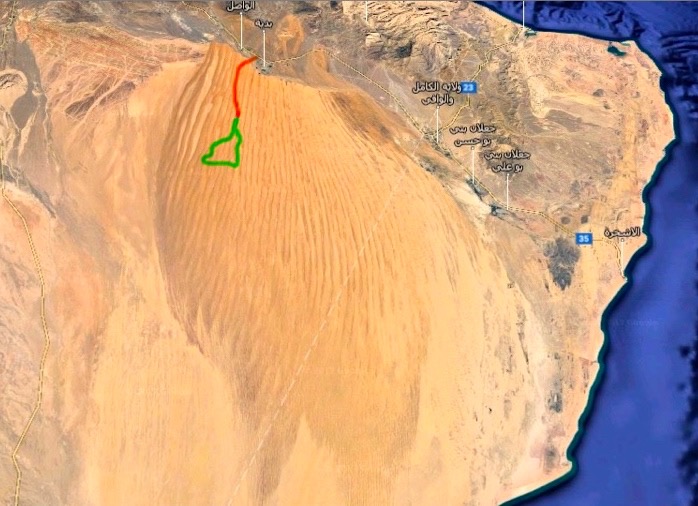
The following pictures are representing the Nomadic Desert Camp and showing you impressions of our evening sunset tour (of course with fresh made Omani Coffee).
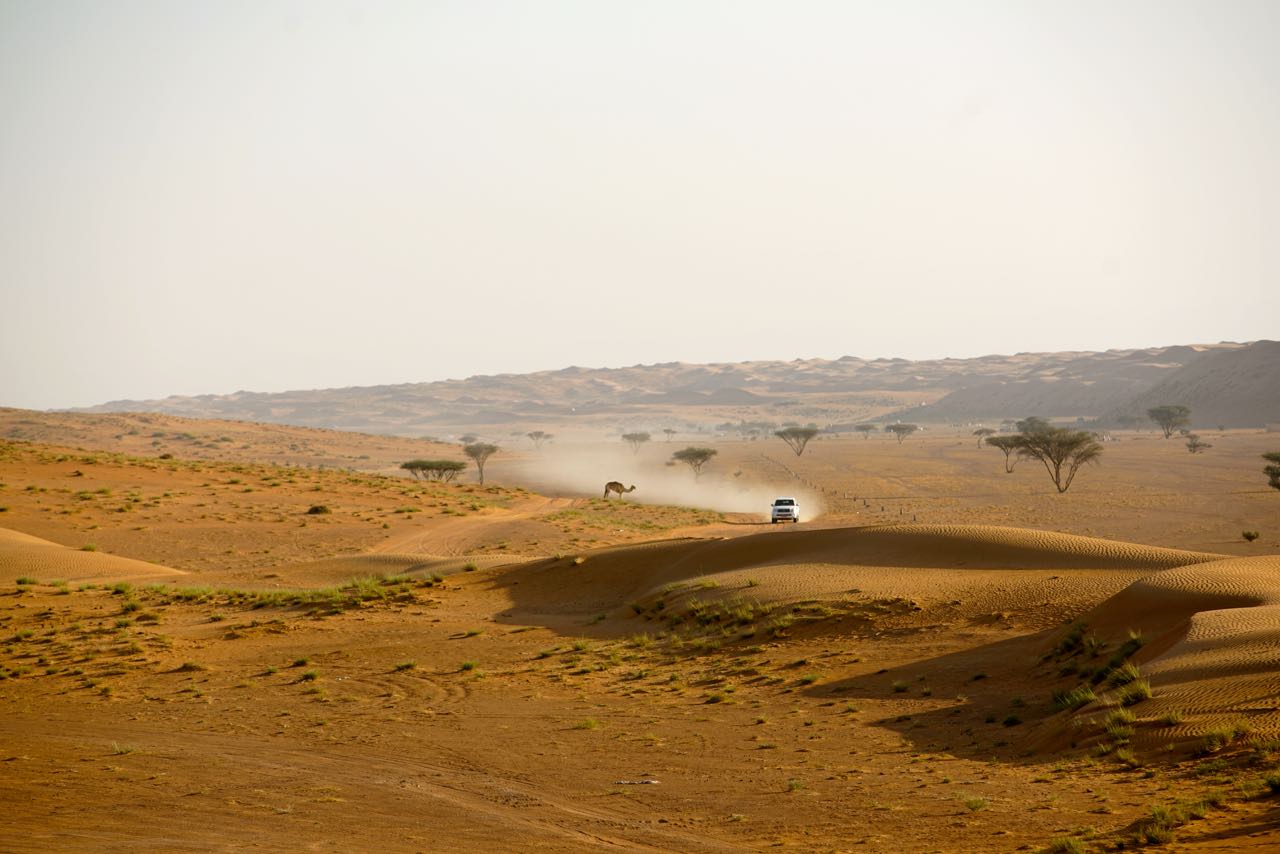
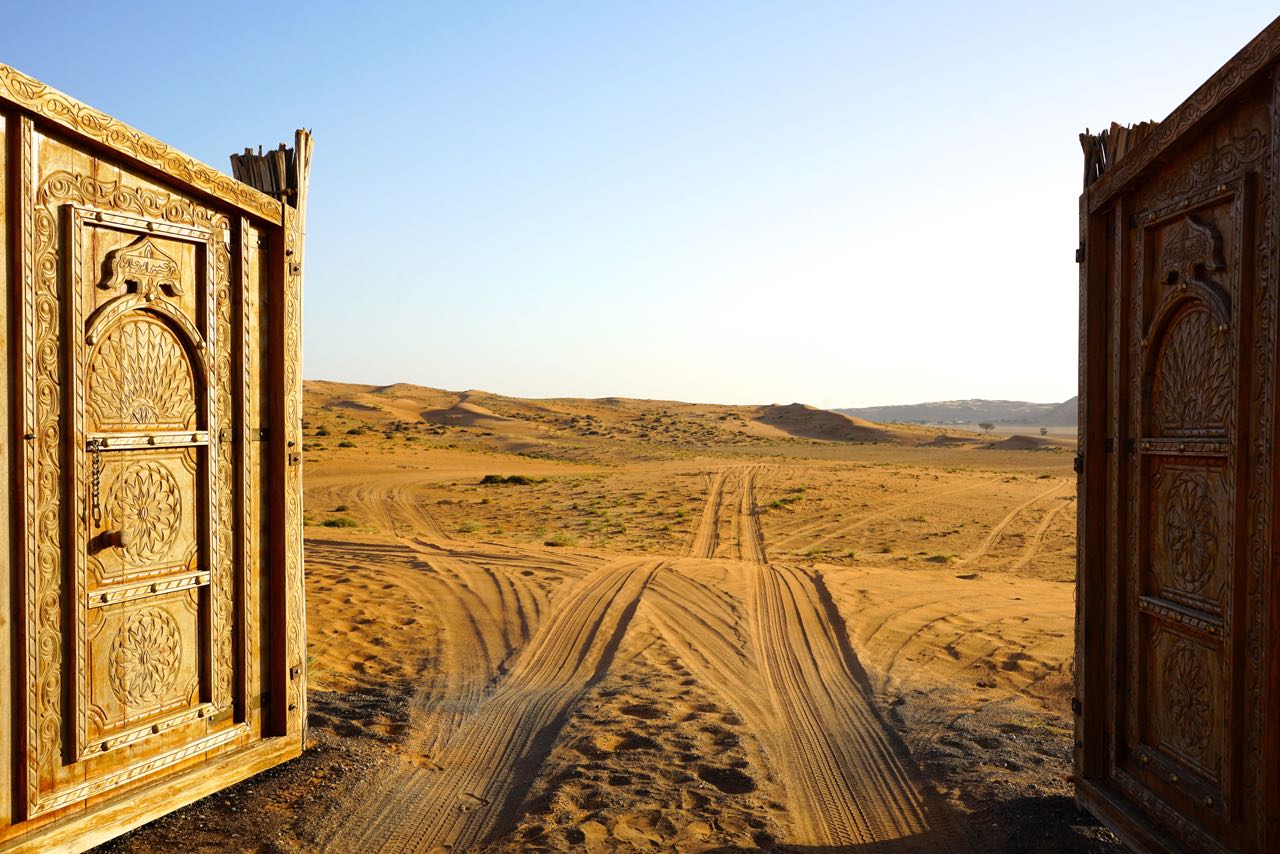
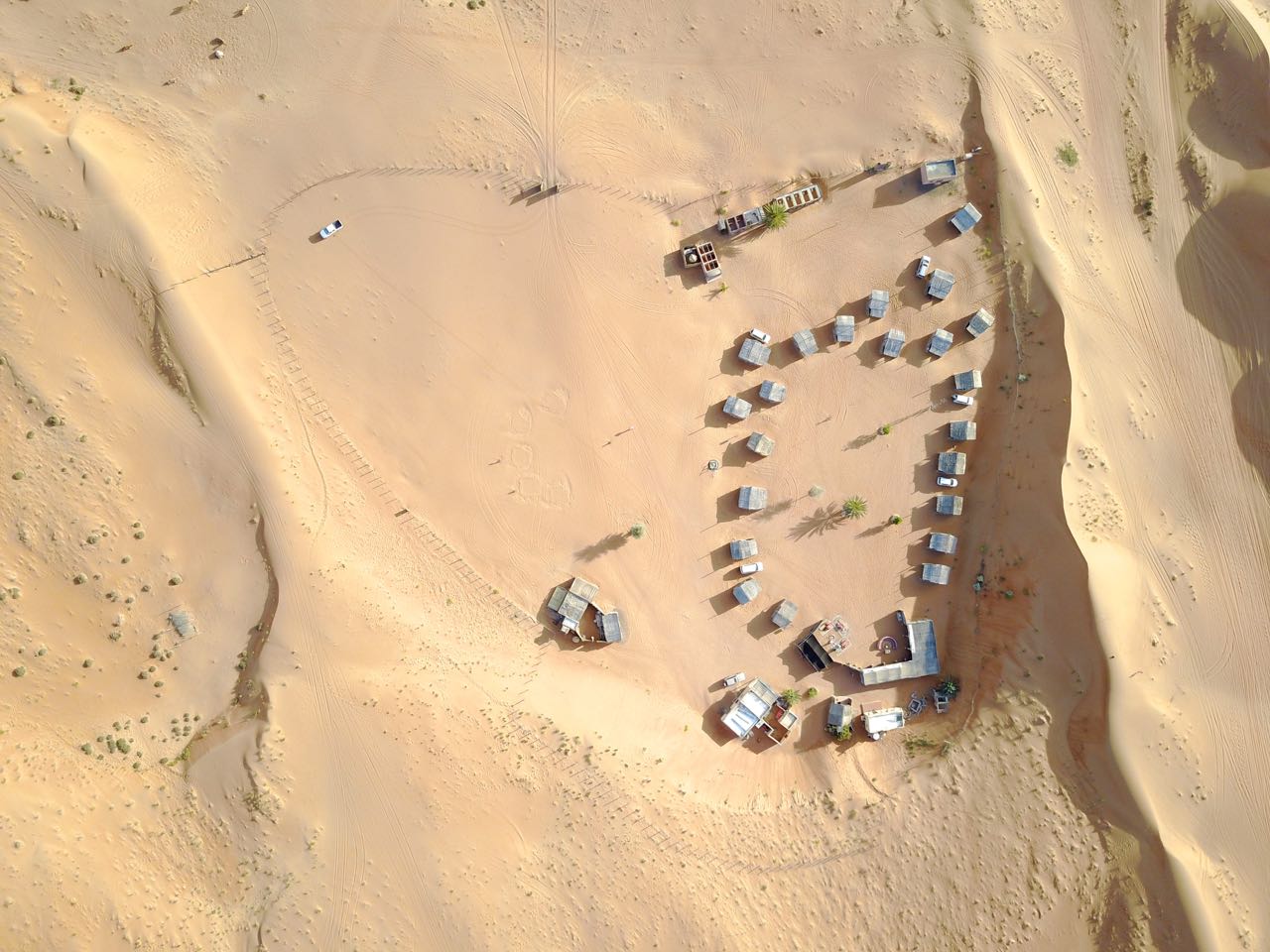
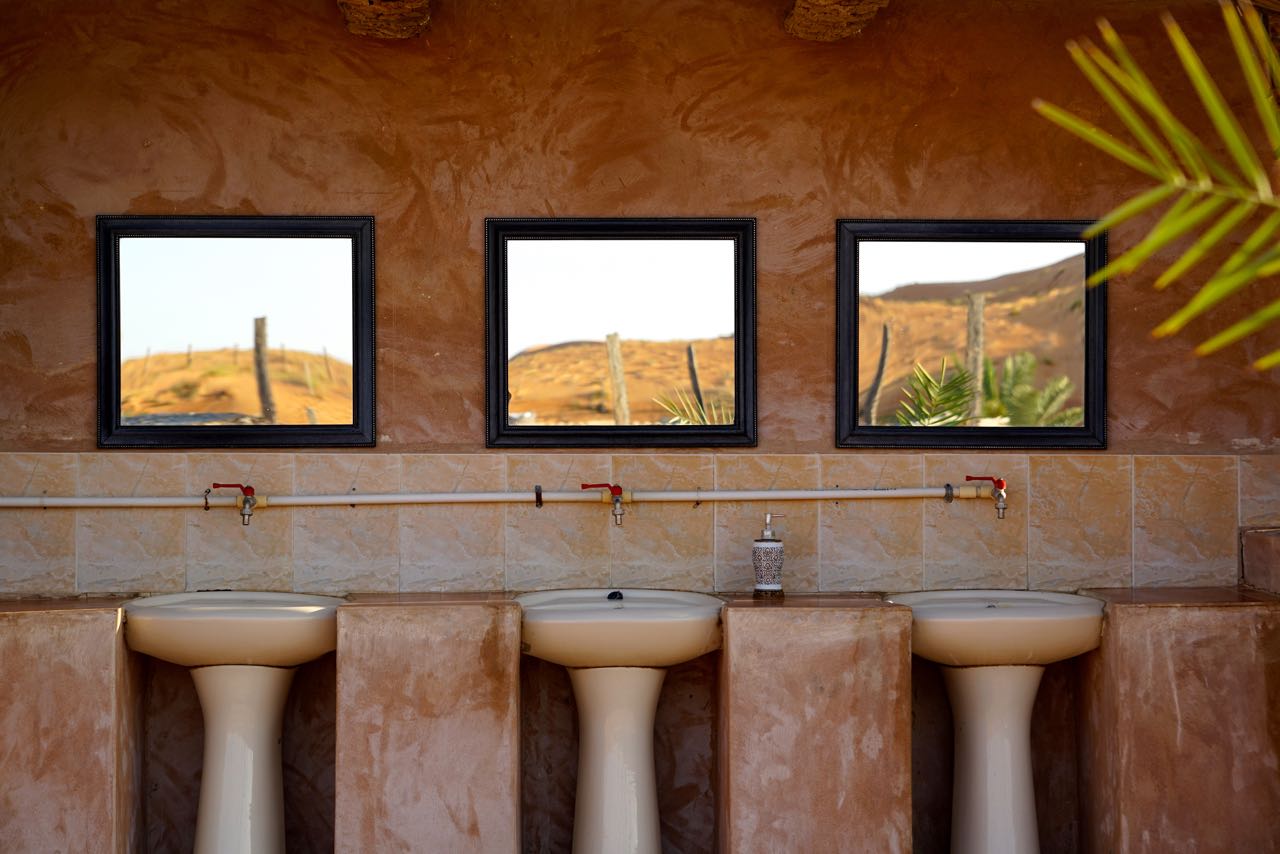

After a warm welcome at the camp with fresh dates and (guess what ???) Omani Coffee, we went for a short off-road drive towards step sand dunes from where we watched the sunset. I know I have mentioned the Omani Coffee several times now, so for those of you, who are curious about it, please follow the link for the Omani Coffee Recipe. With the toes hidden in the warm sand and the last glimpse of the sunset, my mind was quiet and so was our first night at the Nomadic Desert Camp. But before we went to bed, the kitchen prepared some wonderful, traditional and tasty food such as braised lamb, acidic yogurt from the milk of the dromedary, grilled vegetables, and fresh bread. Once more I felt happiness and thankfulness, here in the middle of the desert where little things get valued very high!
Early morning at the next day our dromedary was already saddled up, Christiane and I took another sip of the hot coffee and then we started to cord the rest of our gear, knowing that we will be riding with the dromedary for the next two days deeper into the desert.
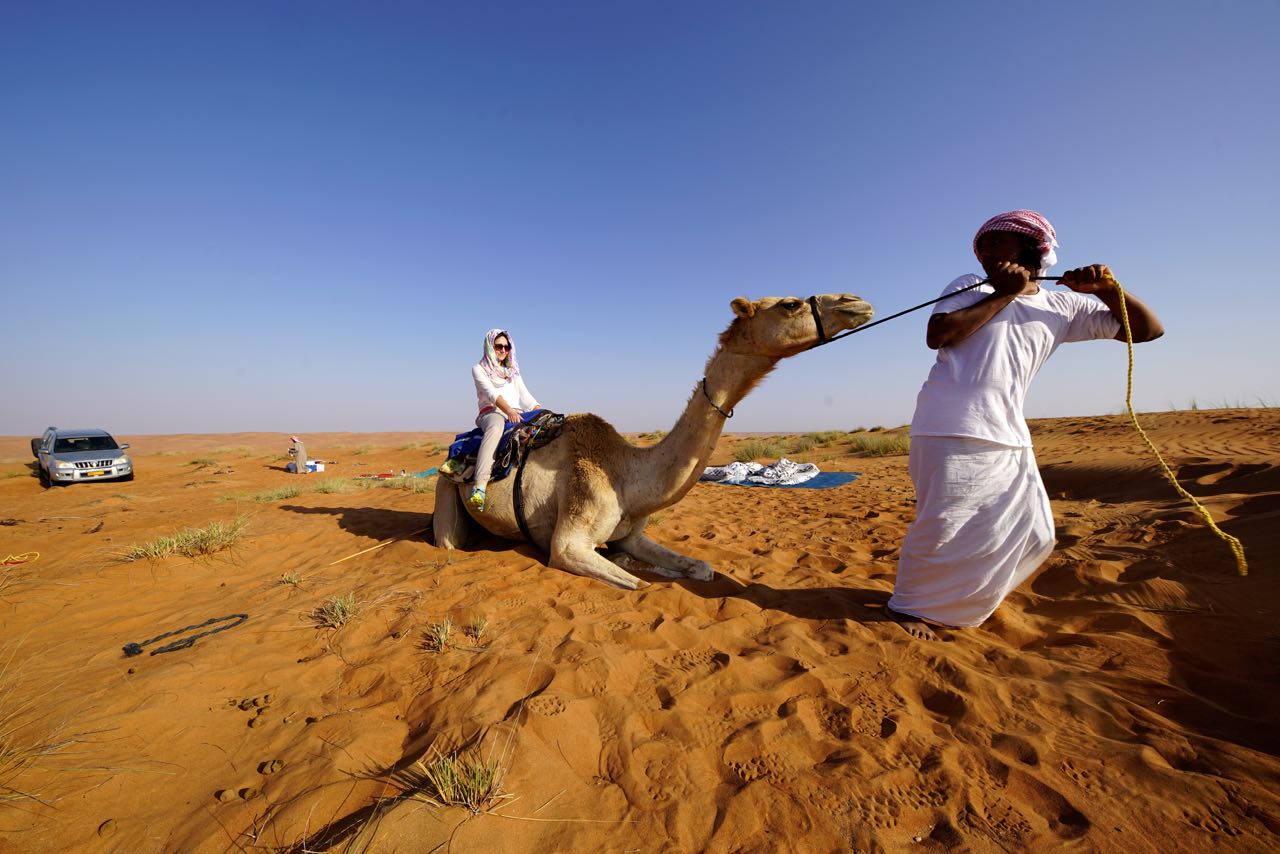
The first hours on the one-humped-camel felt very uncomfortable and uncommonly but then we just followed the rhythm of those graceful animals. I love animals anyway but I am a long-time fan in terms of camels. The issue camel or Dromedary is sometimes confusing so maybe this link will prevent future misunderstandings. The hump of the dromedary contains fat, which the animal will use in case of food shortage to burn off, or in other words to gain energy. It is a big misunderstanding that the dromedary is storing water in its hump… (if necessary they do it in there stomach).
The word ‘dogtrot’ probably describes this rhythmic movement best where you could almost rock yourself to sleep if it would not be so darn hot! We stopped our ride around noon and for that, they have set up a fixed small shelter to hide from the sun. The dromedary did lay down and we did the same. The lunch (or sun-) break lasted for 4 1/2 hours !!! Of course, we had a nice lunch with a few different small yummy things, followed by a nap and… Omani Coffee. We continued our journey and had a fantastic scenery ride till we reached a flat enhanced sand dune, which was shortly before sunset. Our guide quickly set up a campfire and started to bake some bread while Christiane and I prepared our sleeping mats for a night under the open Arabian sky!
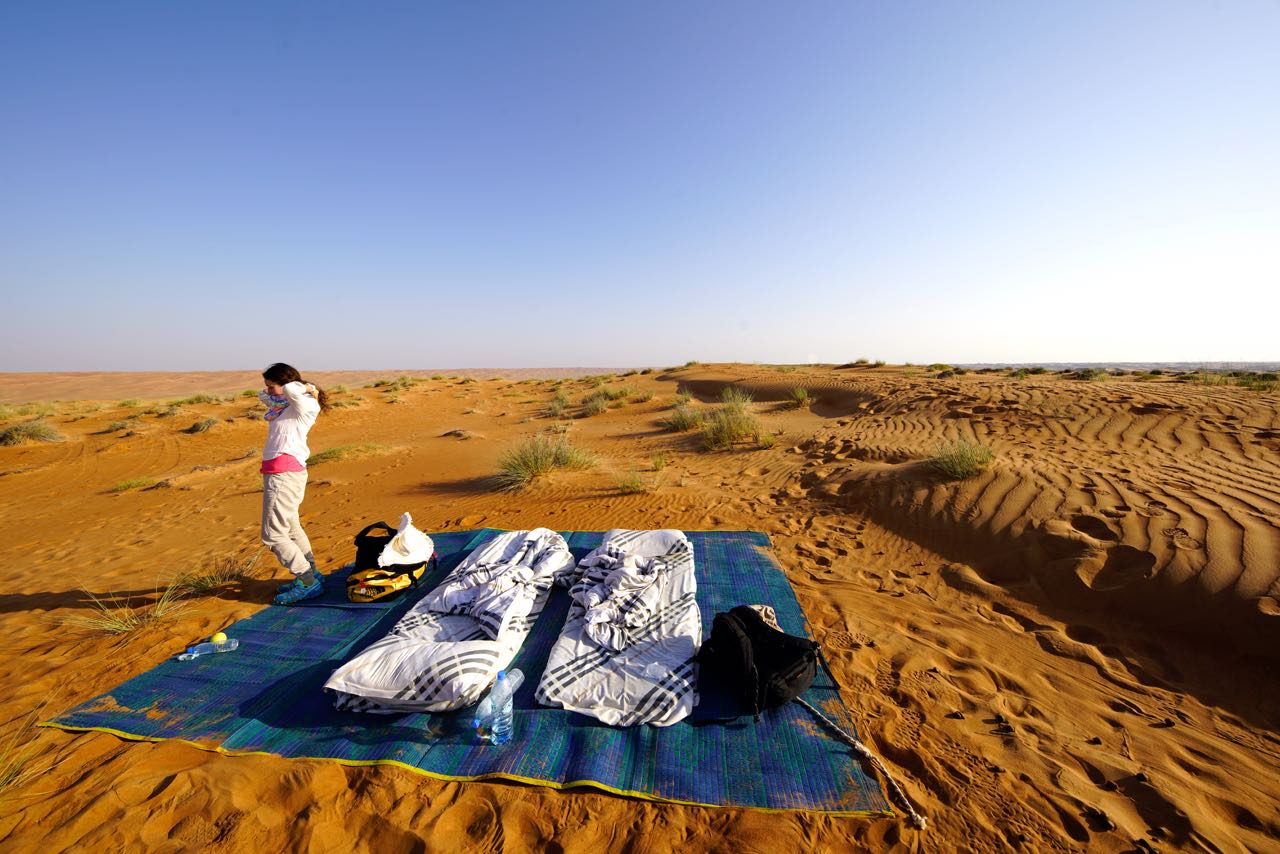
The night was awesome and we were three tiny dots who felt gigantic in his huge desert universe. The food with the incredible odors was cooked over the campfire and the clear air created a bridge to the starry sky. Simplicity showed once again… less is more! Even we have not done any workout (by riding on the dromedary) we felt tired but the sparkling night sky tempted as to play around with our headlamps. The following pictures I have taken with Dji Mavic – Drone while the last pic is taken from 500 meters above the desert ground. If you zoom into the picture you can see our sleeping place, the car and the mats where we had our dinner.
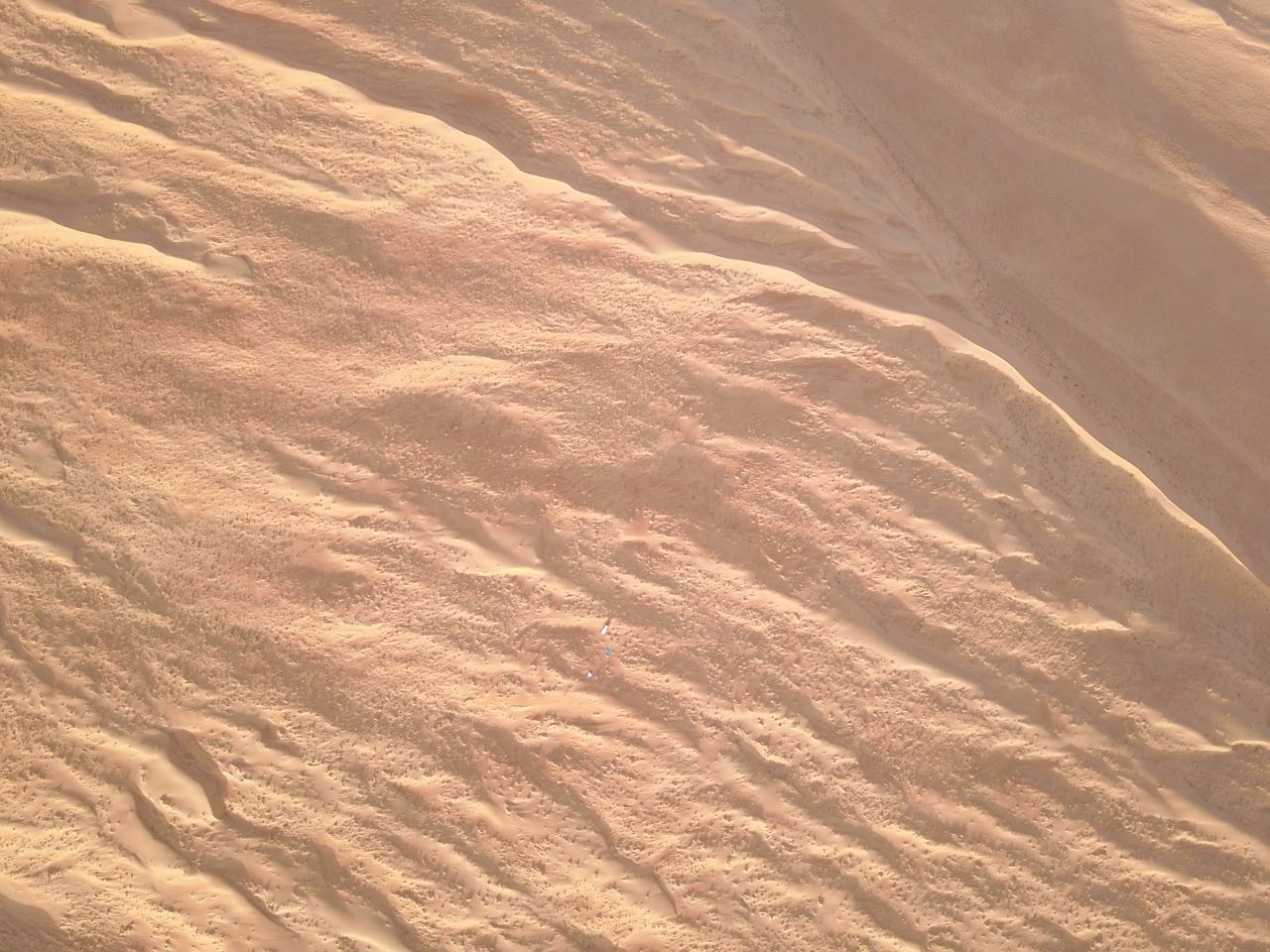
We just slept a few hours and the night was quite cold, waking up however with a fresh cool breeze was something special and fantastic. It is hard to imagine, to describe and to write about this extraordinary feeling on how a cool morning in a usual very hot desert feels like… definitely mesmerising !
The smell of fresh coffee caught our full attention and we did not know if Allah, God or our guide did cook it because nobody was seen (but it tasted great). In the corner of the eye, I saw the smile from our guide while he was pulling out the next pita bread from the hot charcoal of the campfire. After a simple but great breakfast we started to tie up our gear on the patient dromedary, eventually, we had about another five hours to ride back to the Nomadic Desert Camp. It was a meditative long ride and not much has happened along the way… it was not necessary because of the beauty which surrounded us. The dromedary did trot slowly and we turned our backs to the desert, leaving nothing more behind then footprints but taking lots of fantastic memories!
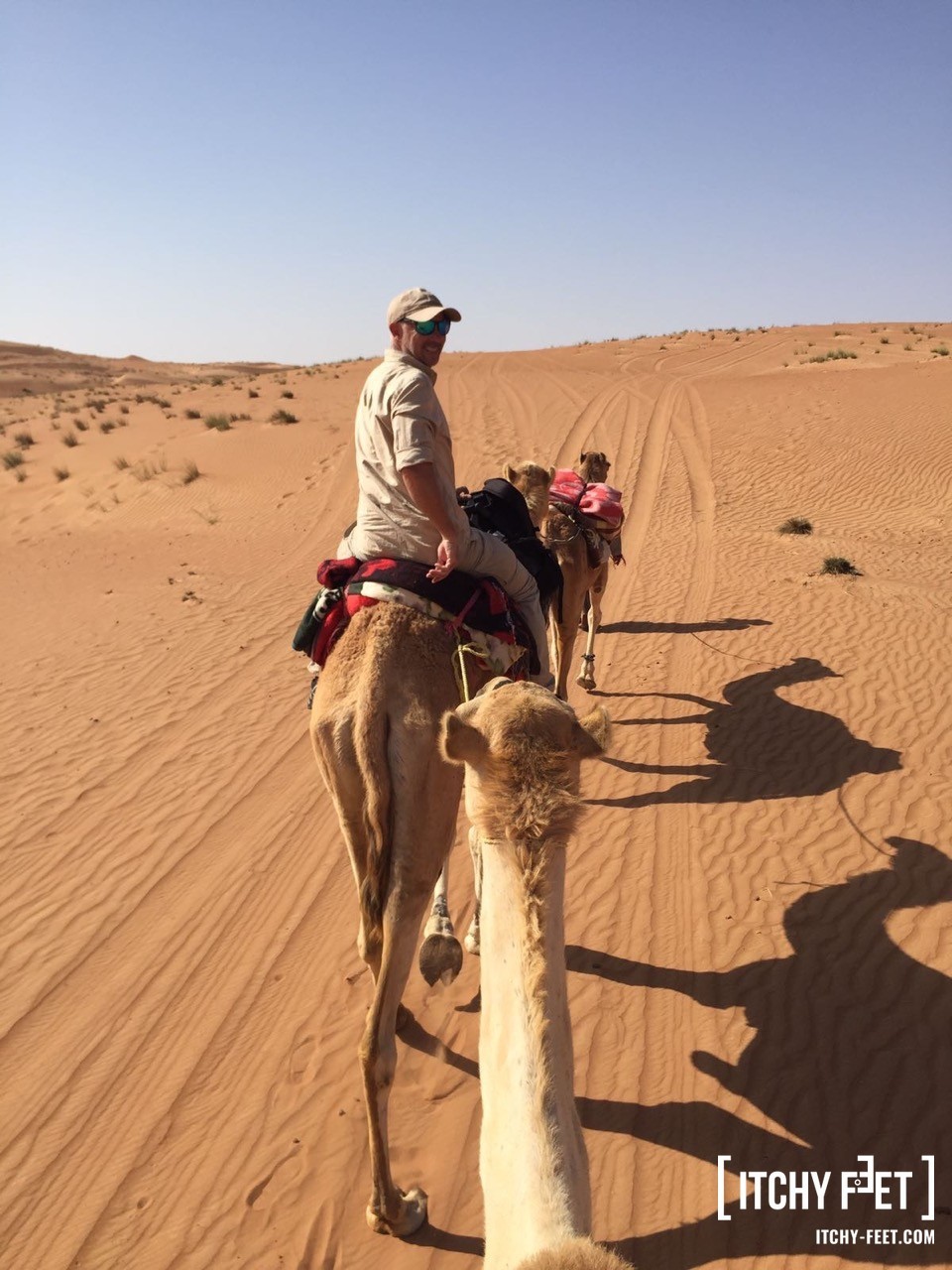
The (Wahiba) Sand has meanwhile literally spread out equally in our car and after filling some air in our tires ‘the pressure was on’ … not for us but for the tires to roll on. Our Toyota 4 x 4 was not the newest, strongest or lightest model but it was really reliable! We stopped at the first petrol station (not for gasoline) but for chocolate ice-cream(s) and with the wonderful taste of it all the heat and dust from the desert vanished. But… our adventure tour through Oman is not over yet and before we will drive tomorrow towards the famous Hajar – Mountains we visited the Misfah old house, about 45 km away from Nizwa (and 220 km from Muscat). The Misfah Old House is a small old and traditional renovated guesthouse in the mountain oasis of Misfah. So for those of you who like it simple and authentic, you will find the whole surrounding and the accommodation option extraordinary. The guesthouse gets booked out quite fast so make sure you have a reservation (or just show up for a great lunch).
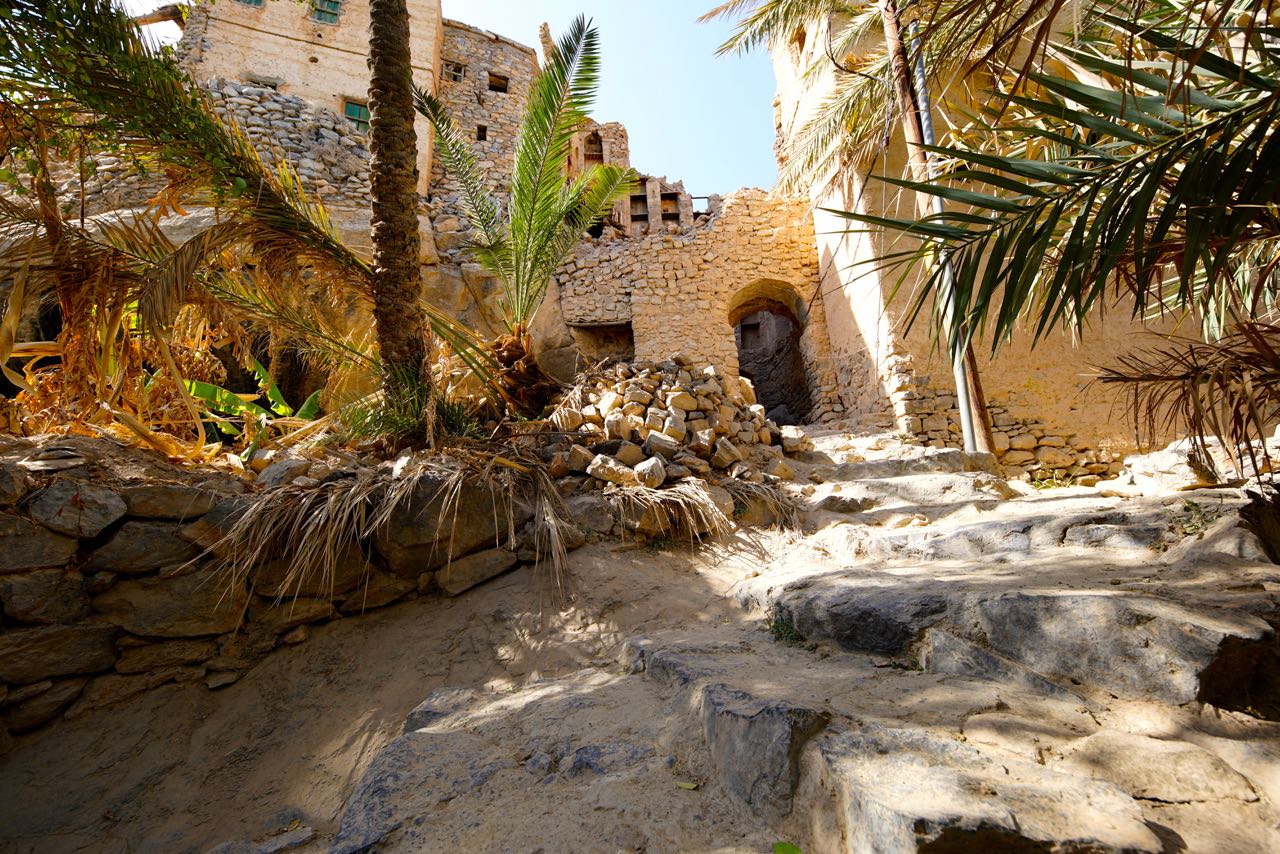
The Hajar mountain range stretches about 450 km from the border region of Oman towards the United Arab Emirates and all the way to the eastern spit of land at Ra’s al-Hadd, in the direction of the Indian Ocean. Actually, the Hajar mountain range frames the Gulf of Oman in a crescentic shape and cuts of the fertile coastal region at Batina from the backcountry. It was late afternoon while we drove the newly paved road to Jebel Shams but we often stopped because of the spectacular scenery and the breathtaking sunset view towards Dschabal Mischt (2090 m.)
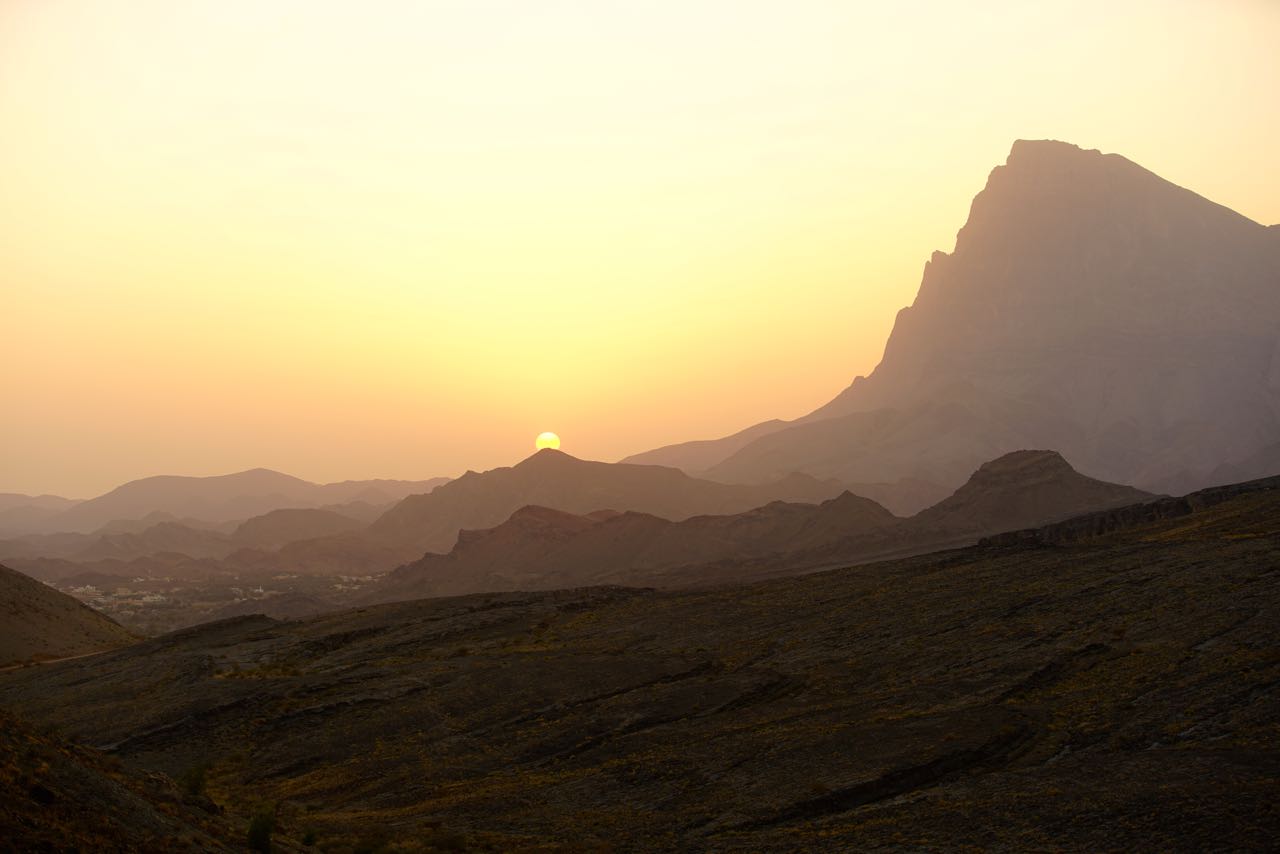
We reached the mountain plateau, which lays a little bit below the southern peak of Jebal Shams (2997 m), shortly before dark and started to set up for the night. Because of the dry and rocky area, we barely found wood for the campfire and at altitudes like that the temperature can drop down to 5 °C. Christiane slept in the car while I tried to find a flat spot close to the fire.
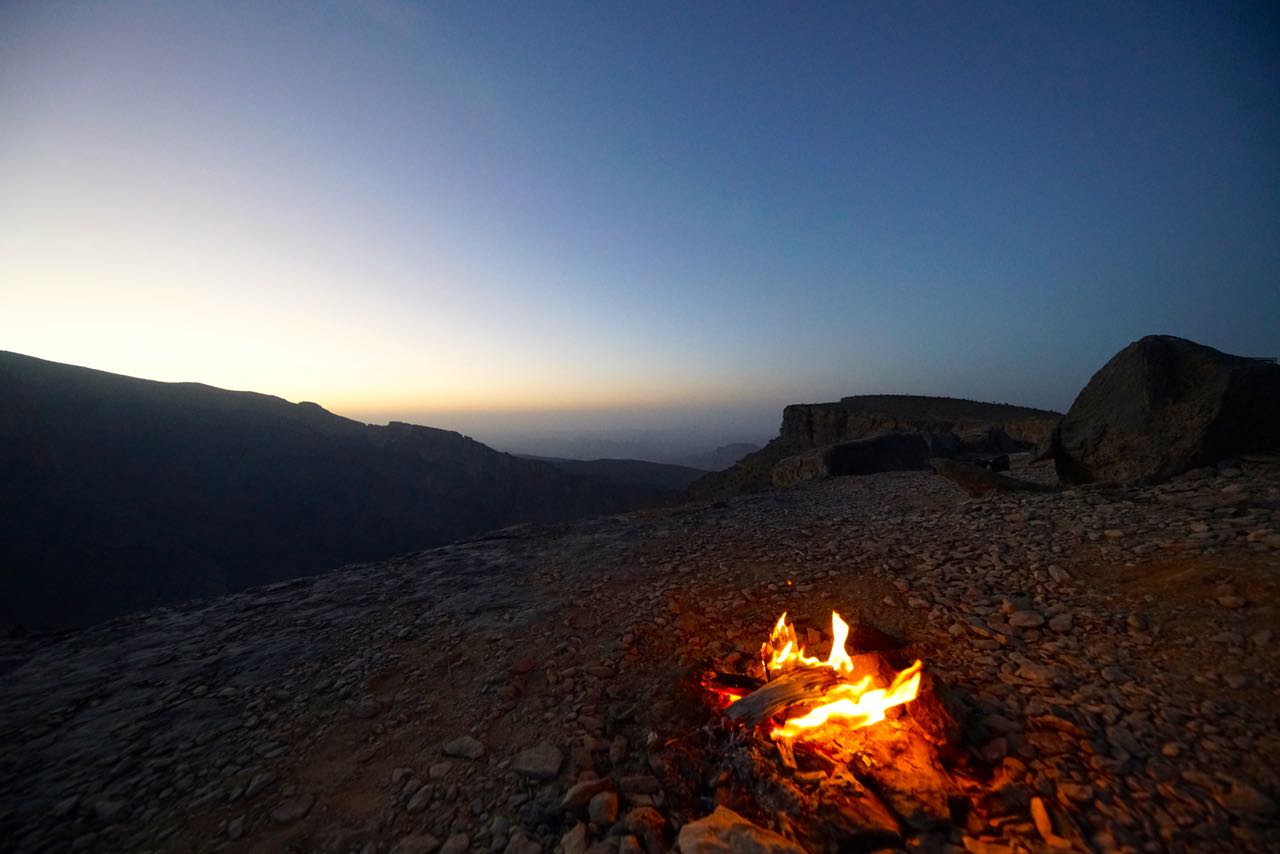
The night was chilly and the bells of a nearby church woke me up (besides the curiosity of some goats which nibbled on my sleeping bag). It was a nice wake (or nibble) up at the right time…. sunrise, I kept a small fire going till Christiane was awake as well and we warmed our hands with shot cup of coffee. We inhaled the great coffee smell and also the magnificent breathtakingly view and just felt happy. With the endless horizon in front, the deep gorge below and the blue sky above us we were chained by amazement.

It was still early in the morning and having a breakfast place like that we did not feel any reason to rush. But that had its price because we had to share our breakfast with the goats. From our overnight camp, we just had to drive a very short distance to a small village called Khateem. Khateem is the starting point for the Balcony Walk, which winds along the edge of high cliffs up the rim of Wadi Nakhr to the abandoned village of As Sab.
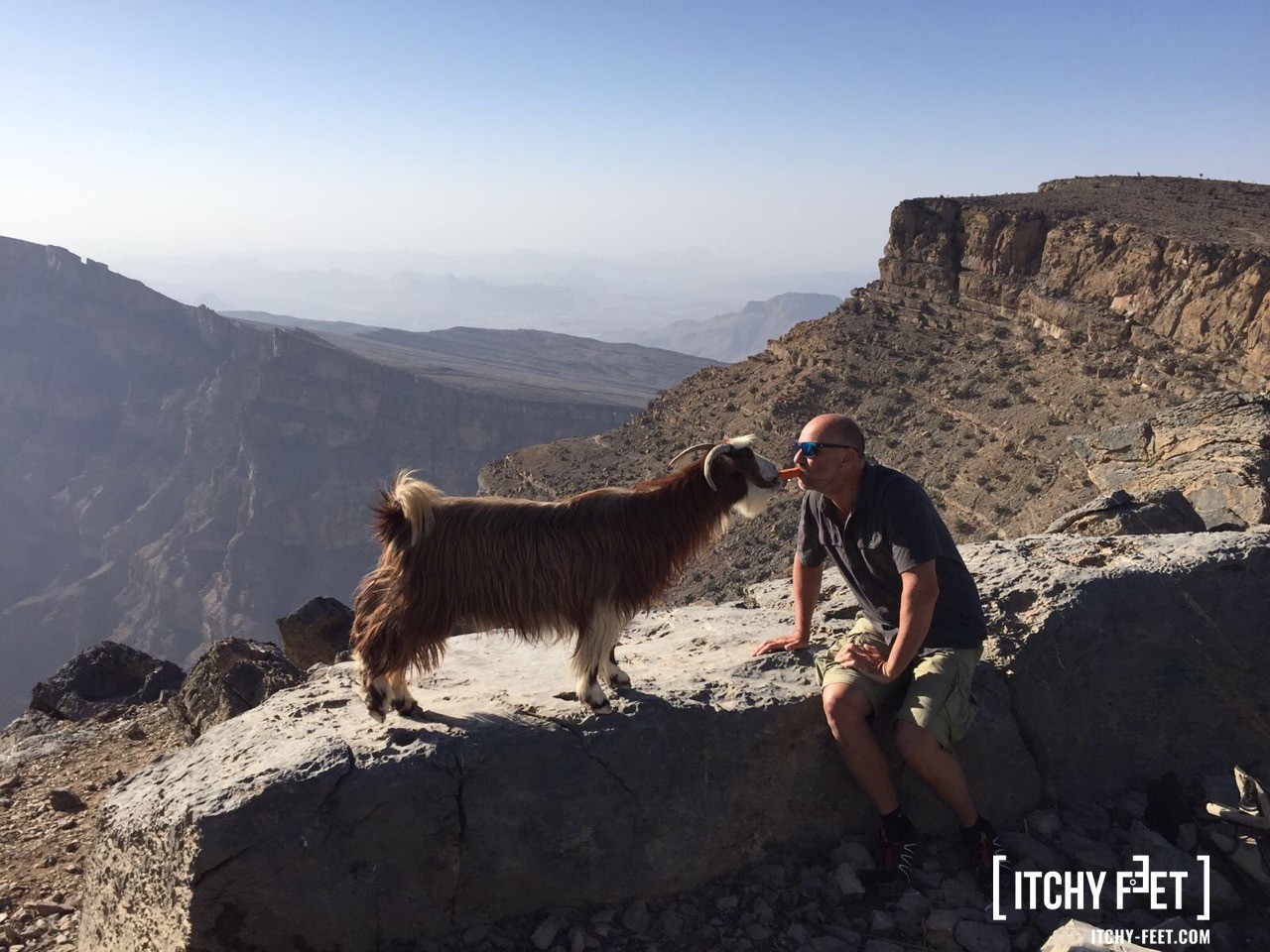
The Jebel Shams, with the height of 3005 m. is the highest mountain in the Sultanate of Oman. The «Grand Canyon of Arabia» is the biggest canyon of the Arabic peninsula. From the village of Al Khateem you just follow the easy and sloping trail along the rock ledge (also called W6 trail). The trail is unsecured and sometimes narrow, the terrain has some steep slopes as well but that should not scare you because you will be rewarded with spectacular and breathtaking views. Tremendous and barely to beat is the dimension of this deep canyon. If you estimate four hours for the whole hike (you have to go back the same way) you will be fine but of course, this is just a personal estimation! But now lean back, enjoy the tour and get inspired by the pictures and the video.
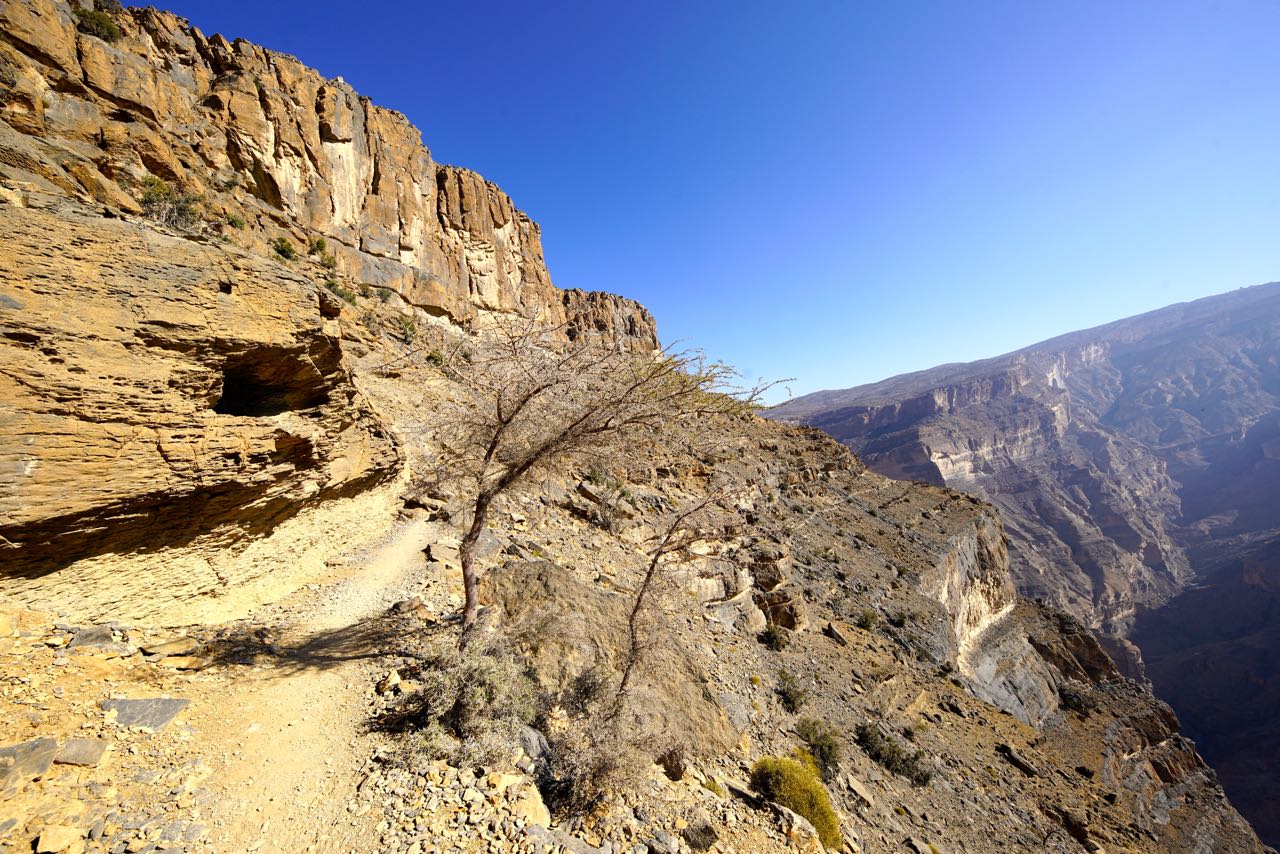
After this impressive hike, we were really taken in (again) from the beauty and wonders of nature. So we took our time by driving down the mountain pass in a very slow matter. Most of the days (nights) on our off-road Oman tour we slept outdoors but for tonight we choose a fancy stylish hotel. The View Hotel is stunning in many ways, its secluded location, the pool and the exposed architecture summaries the impressions and bundles it to a great memory. I often experience that the price-performance ratio is not in balance and it was sad to undergo the same experience here as well. The building materials and quality of it were cheap, the workmanship partly poor and the food ‘medium’. BUT… the staff was whole-hearted (like everywhere in Oman) although, and it’s about time to mention here, laborers are coming from India!
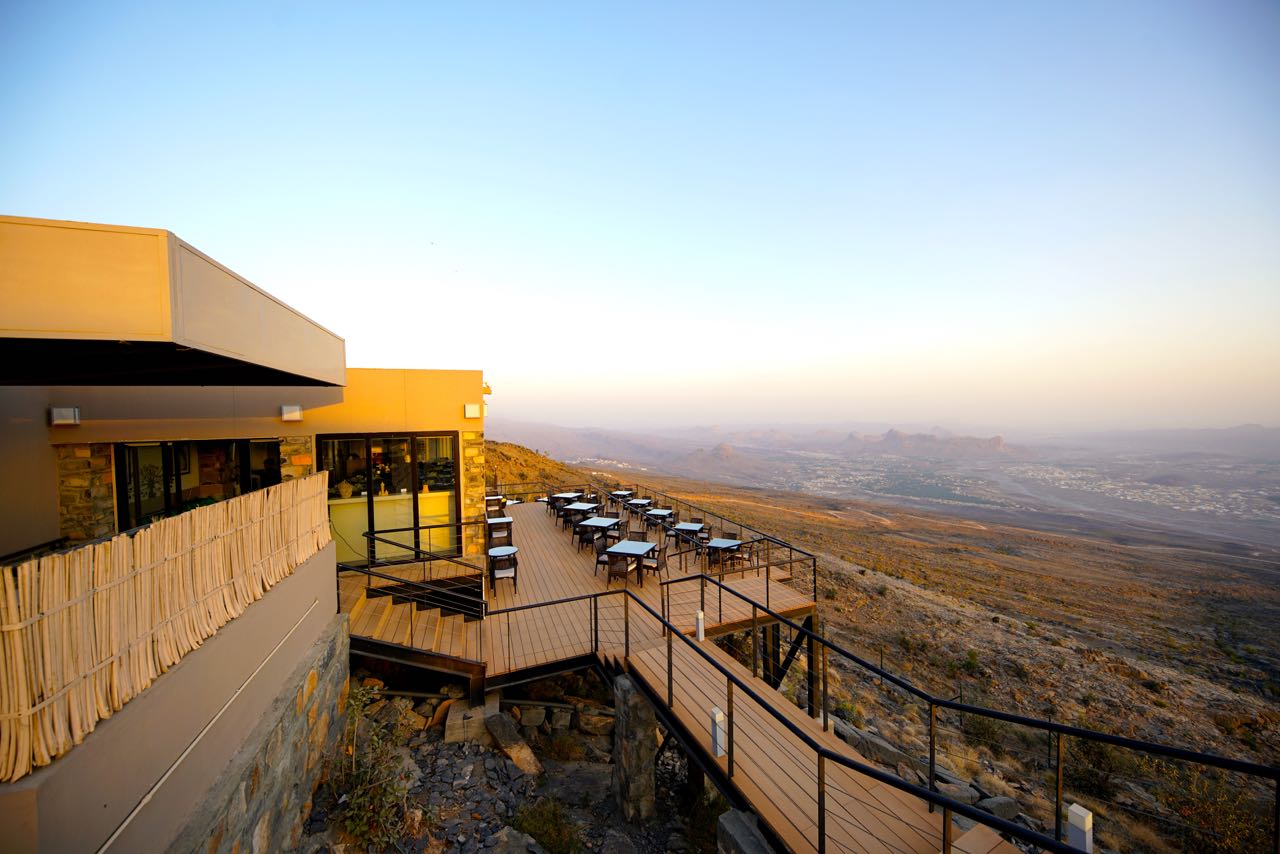
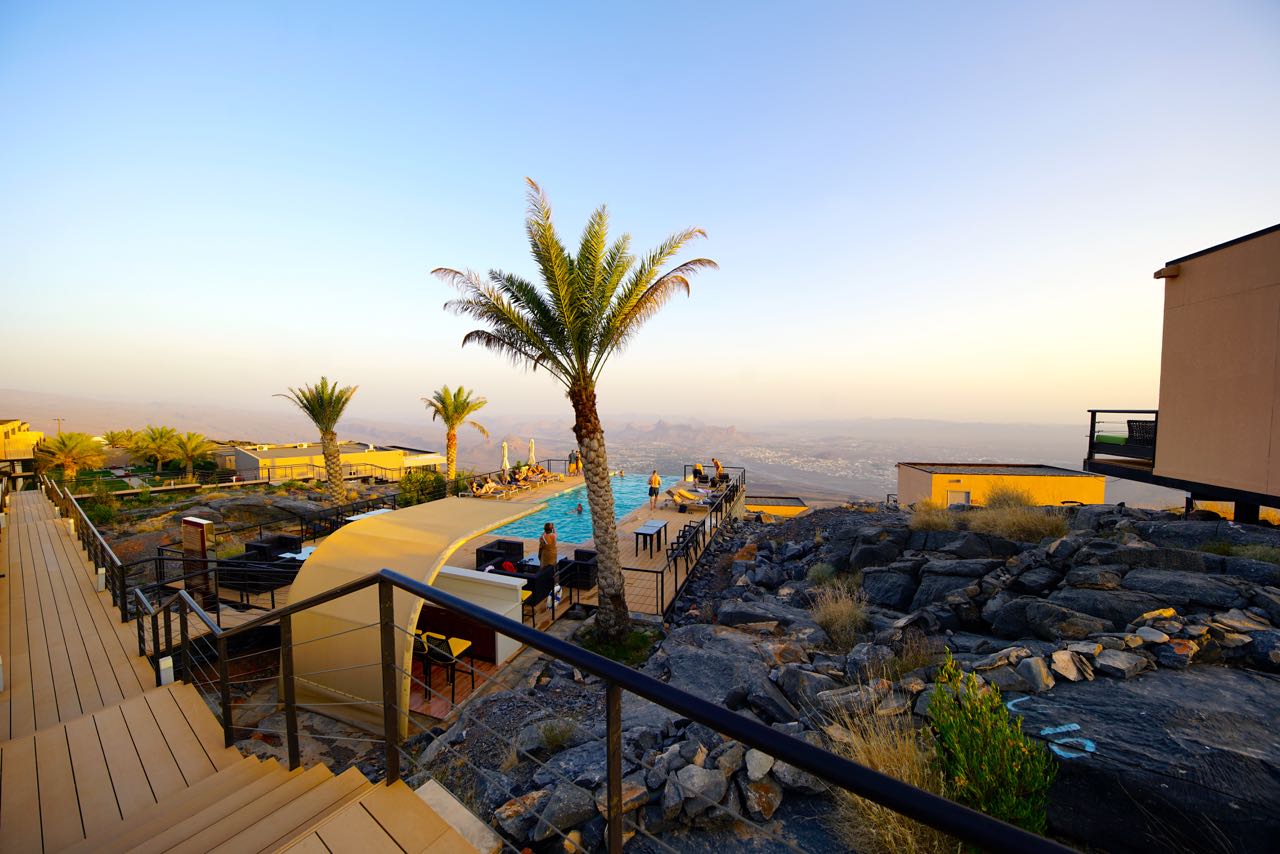
Yes, we feasted and refreshed ourselves without a doubt, especially sleeping on ‘real mattresses’ instead of yoga or inflatable mattresses. After packing and stepping into our meanwhile messy car it was time to move on to the last off-road tour on this trip. It is still early morning and the temperature already reached 30 °C while we drive towards Al Marrat – Jamal Shams (Asar’h). This route is seldom traversed and offers amazing views as well as exposed driving (we loved it). On the top of the mountain and real remote hides the Sunrise Resort which is not easy to find but recommended by outdoor enthusiasts. So for those of you looking for it here comes the hint… it lays in the province of South Patina Rustaq (on the northwest side) of Jebel Shams and you can reach it by driving the road from Al Hamra (39 km). It sounds confusing to you…? If so get used to it because finding off-road tours or places is often confusing in Oman. That’s why I like to mention the: Oman-off-Road-Explorer book again! Without it, we would not have found even a fractional amount of the tours we drove.
With 48 hours left in Oman and totally astonished on how many adventures we squeezed into this trip, we moved on. Such a short time and so many impressions in terms of culture, deserts, off-road driving, mountains, ocean sites, people, pictures we took (and 5000 words in two blogs) are mixing our experiences up to an unforgettable ‘Omani Cocktail’. Mesmerised through the tour description we drove towards Wadi An Nakhur, the deepest canyon in the middle east and the second deepest worldwide (after the Grand Canyon in Arizona). For a better overview of the Hajar – Mountains just use the link but I am not sure if the link will contribute to a better understanding or if it conduces to more confusion about the region.

Driving into the canyon of Wadi An Nakhur is sensational and breathtaking because when you travel through Oman you get used to looking down from high above into step gorges but here it is the exact opposite! On this bumpy off-road drive, the steep rock walls rise like skyscrapers and you look up gigantic rock formations while getting deeper and deeper into the gorge of the Omani Grand Canyon. Huge boulders lining up along the trail and the steep cliffs, which can rise up to 1000 meters, throw scary shadows. Once again I felt smaller than the tiny lizards which you can find here when nature ‘shows off’ with such impressive power. Amazement and adventure pure! It surprised us that such a spectacular route is not overcrowded (we encountered two cars the whole day). But the best is yet to come because you will NOT FIND any souvenir shops, restaurants, tourist information or any other urban distractions along the way.
https://www.youtube.com/watch?v=60GWw4_ueng&t=5s
Warning !!! If it is overcast or if it looks like rain you should NOT drive into the canyon(s). Most likely those conditions are getting underestimated and are the primary reasons why every year, a couple of people die, by ignoring such warnings. Heavy rain can easily cause spring tides!
And yes… there is such a village as Al Nahkur, it exists! After driving about 7 km on this bumpy road you reach a dead end where six families settled. From the tiny village, it is worthwhile hiking and exploring the area, just following the small stream which guarantees you incredible views. If you walk for about 30 min. you will reach a point where you even can see and recognize the Balcony Walk at Jebel shams, 1000 meters above you.
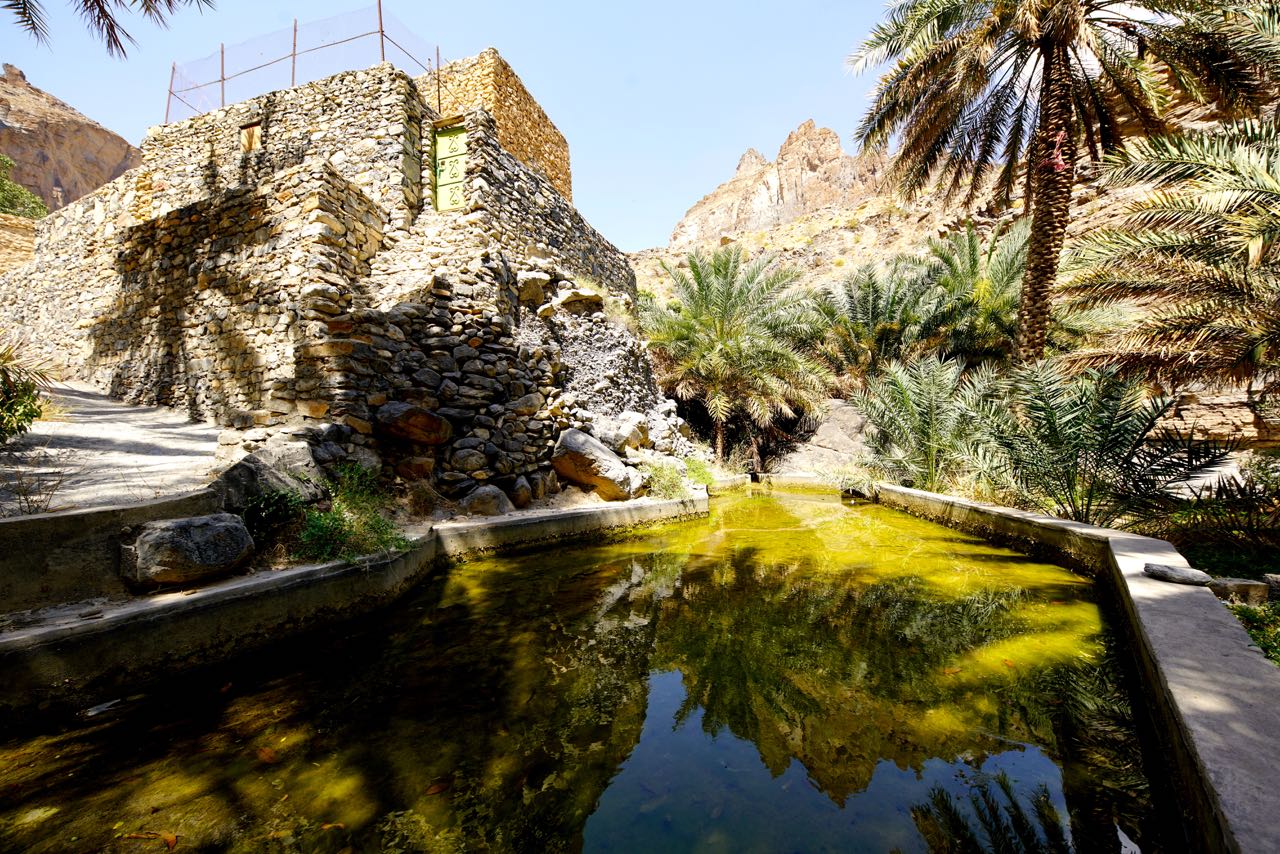
Still astonished and dizzy from the great impressions of Wadi An Nakhur we started slowly to drive back to Muscat, the capital city of the Sultanate of Oman. For our last night, we drove to Wadi Damm, which became ‘World Heritage Site’ by the UNESCO. The UNESCO awards a place with the title: World Cultural Site or World Heritage – natural site due to uniqueness, authenticity and integrity significance. Meanwhile, I have seen many of those so-called ‘ World Heritage Sites’ and I questioned myself (like here at Wadi Damm) if the UNESCO follows up after the awarding to control such places regularly if they still fulfill the requirements !!! After all the pollution and contamination I saw here, I doubt that strongly !!!
It is a pleasure using the same words like in the introduction of the blog to say goodbye… fascinating, moving and an oriental mixture of ‘Thousand and One Nights’ with modern times… were our first and our last impressions at the Sultanate of Oman. April 2017


